Review Article - (2022) Volume 14, Issue 1
Therapeutic Potential of Culinary Spices
Ramanpreet Walia1*,
Shikha Saxena1,
Akanksha Singh1,
Reecha Madaan2,
Swati Madaan1 and
Avneet Kaur Lamba3
1Department of Drug Development and Research, Amity University, Noida, Uttar Pradesh, India
2Department of Drug Development and Research, Chitkara University, Punjab, India
3Department of Drug Development and Research, Gurugram University, Haryana, India
*Correspondence:
Ramanpreet Walia, Department of Drug Development and Research,
Amity University, Noida, Uttar Pradesh,
India,
Email:
Received: 18-Feb-2022, Manuscript No. IJDDR-22-11573;
Editor assigned: 21-Feb-2022, Pre QC No. IJDDR-22-11573(PQ);
Reviewed: 07-Mar-2022, QC No. IJDDR-22-11573;
Revised: 11-Mar-2022, Manuscript No. IJDDR-22-11573(R);
Published:
18-Mar-2022, DOI: 10.36648/0975-9344.22.1.170
Abstract
Spices are herbs used as flavoring, aromatic and coloring
agents. The culture of various countries even involves
incorporation of spices on a daily basis, not just for their
culinary potential, but also for the health benefits they
provide. In fact, many age-old scriptures suggest the
incorporation of Indian System of Spices in everyday meals
to counter many diseases and keep them at bay too. The
fact that dietary factors play an important role in treatment
as-well-as prevention of diseases, makes it all the more
important to conduct research and provide scientific
evidence regarding the use of culinary species as potential
agents with a therapeutic effect. Such culinary spices have
various active phytoconstituents which can have many
therapeutic effects and also prove to be great antimicrobial,
antidiabetic, anticancer etc. agents. Generally, most of the
allopathic drugs are taken individually but unlike them, the
spices are consumed in combinations to provide the effect
which would be of use to us. Also, due to lesser chances of
side effects and treatment of the root cause of any disease, it would be safer and more practical to head for herbal
drugs for treating diseases and various other ailments.
Keywords
Spices; Culinary herbs; Pharmacological potential
; Phytoconstituents, Culinary spices
INTRODUCTION
Plants have been a valuable source of natural products for a
long period of time to maintain health and wellbeing, especially
with more research studies in the last decade for natural
therapies. These culinary spices have been used for not only
flavoring food and giving aroma but also to provide
antimicrobial properties, relief from asthma, antioxidant power,
analgesic activity, relief from Menopausal syndrome and much
more. Some of the culinary spices which have been studied for
their therapeutic potential are mentioned in the following table
along with their scientific profile and phytoconstituents which
possess significant pharmacological properties [1-10].
| Common name |
Scientific name |
Family |
Phytoconstituents present |
| Celery |
Apium graveolens |
Apiaceae |
Flavonoids, Steroids, Carbohydrates, Phenols, Limonene, Selinene Frocoumarin, Glycosides, Vitamin A, Vitamin C, Caffeic acid, p-coumaric acid, Ferulic acid, Apigenin, Luteolin, Tannins Saponin, Kaempferol. |
| Aniseeds |
Pimpinella anisum |
Schisandraseae |
Shikimic acid, Linalool, Quercetin, Anethole, Gallic acid, Limonene. |
| Lemon grass |
Cymbopogon citratus |
Poaceae |
Geranial, Neral, Citronellal, Terpinolene, Geranyl acetate Myrcene, Terpinol, Methylheptenone, Flavonoids, Luteolin, Apigenin, Quercetin, Isoorientin 2’-O-rhamnoside. |
| Bay leaves |
Laurus nobilis |
Lauraceae |
Flavones, Flavonoids, Alkaloids, Linalool, Eugenol, Anthocyanin Methyl chavicol, Pinone, Sesquiterpene lactones,Phenols carotenoids |
| Oregano |
Origanum vulgare |
Lamiaceae |
Vitamin K, Vitamin E, Calcium,, Magnesium, Thymol, Carvacrol Linolool, Myrcene, Cymene,Terpinene, Caryophyllene. |
| Nutmeg |
Myristica fragrans |
Myristicaceae |
Myristicin, Licarin a-e, Nectandrin, Malabaricone B, Malabaricone C. |
| Saffron |
Crocus sativus |
Iridaceae |
Crocin, Picrocrocin, Safranal, α-crocetin, Lycopene, Zeaxanthin, Vitamin B2 |
| Rosemary |
Rosmarinus officinalis |
Lamiaceae |
Rosmarinic acid, 1,8-cineole, Camphene, α-pinene, α-terpeniol |
| |
|
|
Borneol, Luteolin, Hesperidin, Gallocatechin,Genkwanin. |
| Cayenne |
Capsicum annuum |
Solanaceae |
Capsaicin, Dihydrocapsaicin, Nordihydrocapsaicin |
| |
|
|
Homodihydrocapsaicin. |
| Thyme |
Thymus vulgaris |
Lamiaceae |
p-cymene, γ-terpinene, Thymol, Geraniol, Linalool, Carvacrol, Terpinen-4-ol. |
| Parsley |
Petroselinum crispum |
Apiaceae |
Apigenin, Apiin, Myristicin, Coumarins, Apiol. |
| Sage |
Salvia officinalis |
Lamiaceae |
Rosmarinic acid, Camphor, Borneol, Quercetin, Chlorogenic acid, Pinene, Thujone, Cineole, Rutin, Ellagic acid, Epicatechin. |
| Curry leaves |
Murraya koenigii |
Rutaceae |
Linalool, Elemol, Geranyl acetate, Myrcene, Allo-Ocimene, α-Terpinene, Neryl acetate. |
| Allspice |
Pimenta dioica |
Myrtaceae |
Eugenol, Gallic acid, Ericifolin, Quercetin. |
| Wild mint |
Mentha longifolia |
Lamiaceae |
Pulegone, Menthol, Menthone, Borneol, Isomenthone, 1,8-cineole. |
| Jalapeno |
Capsicum annuum |
Solanaceae |
Capsaicin, Dihydrocapsaicin, Coumaric acid, Cinnamic acid, Vanillin, Caffeic acid, Phenylalanine. |
| Liquorice |
Glycyrrhiza glabra |
Fabaceae |
Glycyrrhizin, Glabridin A and B, 18 β-glycyrrhetinic acid, Isoflavones. |
| Chicory |
Cichorium intybus |
Asteraceae |
Inulin, Coumarins, Sesquiterpene lactones, Anthocyanins, Tannins, Chlorogenic acids. |
| Marjoram |
Origanum majorana |
Lamiaceae |
α-pinene, β-pinene, p-cymene, γ-terpinene, Terpinolene, α-phellandrene, β-phellandrene, Camphene, D-limonene, α-terpinene. |
| Basil |
Ocimum basilicum |
Lamiaceae |
Eugenol, ursolic acid, 1.8-cineole, linalool, β-caryophyllene. |
The present review focusses on the detailed important
pharmacological properties of these miniatures which are
potent in even small quantities as reported by various
researchers [11-20].
Literature Review
Aniseed
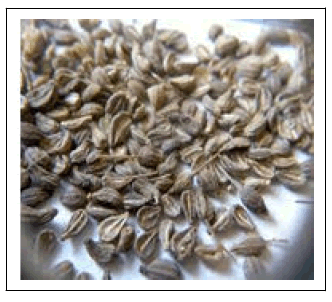
These are native to the Eastern Mediterranean regions, Spain, West Asia, Mexico, Egypt and Middle East. The main constituent of star anise is shikimic acid which is responsible for its anti-viral properties and use in Influenza A and B medication-Oseltamivir. Star anise has broad spectrum pharmacological effects, like- GABA ergic, antibacterial, antifungal, antiviral, insecticidal, anticonvulsant, muscle relaxing, anti-spasmodic, reduction of menopausal hot flashes and pain in dysmenorrhea, anti-oxidant and increased glucose absorbing properties. Its hydrochloric extract provides properties. Following are the chemical structures of the phytoconstituents responsible for the therapeutic potential of aniseed
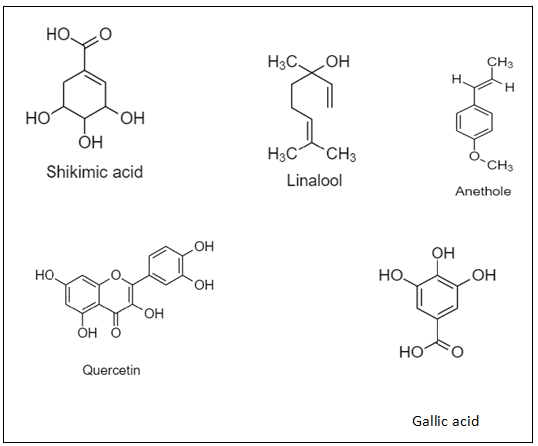
A study was conducted wherein they investigated the in vitro antibacterial activity of Pimpinella anisum fruits extracts against some pathogenic bacteria. Extracts of its fruit were prepared in different solvents like water, petroleum ether, 50% (v/v) methanol and acetone to test its antibacterial activity against four pathogenic bacteria namely Streptococcus aureus, Escherichia coli, Klebsiella pneumoniae and Streptococcus pyogenes. This testing was done through disc diffusion method. It was found that acetone and petroleum ether extracts could not exhibit any antibacterial activity against these bacteria. On the contrary both aqueous and methanolic extracts exhibited some antibacterial activity. The aqueous extract was found to exhibit better antibacterial properties than methanolic extract [91-100].
A study was conducted to investigate the antimicrobial effect of ethanolic and water extract of aniseeds against Candida albicans and other bacterial species through disc diffusion method. The antibacterial effect of water extract was found to be effective against Candida albicans and against other garm negative bacteria like Pseudomonas aeruginosa and Escherichia coli.
On the contrary, the ethanolic extract of aniseeds did not show any antibacterial activity against Candida albicans but against other tested bacteria [101-120].
A study was conducted to study the effect of anise oil in broiler performance as in broiler nutrition and growth promoting substances in place of antibiotics. The control group was administered with 0.1% Avilamycin antibiotic.
The study groups were administered with 100 mg/kg, 200 mg/kg and 400 mg/kg of anise essential oil respectively. The results revealed that addition of 400 mg/kg of anise essential oil improved the daily live weight gain by 15% as compared to the control group. In the control group, only 7% improvement was seen [121-130].
Conducted a screening of antioxidant properties of seven Umbelliferae fruits [including Pimpinella anisum] from Iran. Out of all the extracts, Pimpinella anisum extract exhibited the strongest antioxidant and free radical scavenging activity [131-139].
The total flavonoid content of all extracts was also determined by aluminium chloride technique, which revealed that the extract of Pimpinella anisum had highest amount of flavonoid content. Its ethyl acetate fraction was found to have the highest antioxidant activity as-well-as flavonoid content. Also, antioxidant potency and flavonoid content were found to be directly correlated with each other [140-150].
Lemon grass
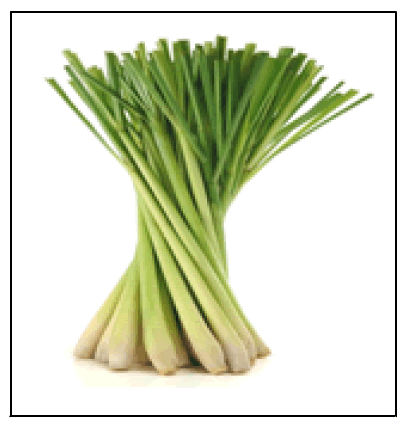
Lemon grass is a plant native to tropical countries, mainly South-east Asia. It has antifilarial, anti-inflammatory, antidiarrheal, antimutagenic, hypolipidemic, antioxidant, hypocholesterolemic and hypoglycemic properties. Following are the chemical structures of the phytoconstituents responsible for the therapeutic potential of lemongrass
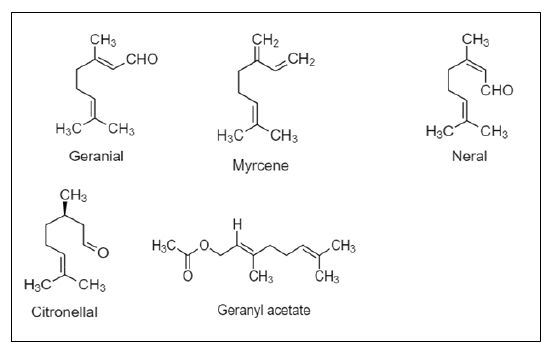
Studied the anti-microbial activity of essential oils from various Brazilian plants including that of Cymbopogon citratus. The aerial parts of the plants were steam distilled. Further, the test was conducted by the GC/MS method. The essential oils were tested as ethanol+water solutions [20 mg/ml]. Streptomycin and Amphotericin B were taken as positive control groups for antibacterial and antifungal effects, respectively. The essential oil of Cymbopogon citratus showed significant antibacterial and antifungal against Bacillus subtilis and T.mentagrophytes, respectively. On the contrary, it showed marginal/lesser antibacterial and antifungal effects against M.smegmatis and Aspergillus, respectively [151-160].
Studied the in vivo antimalarial effect of essential oil of Cymbopogon citratus and Ocimum gratissimum on Plasmodium berghei infected mice. The essential oils from both the plants showed quite significant antimalarial activity against Plasmodium berghei. For positive control group, rats were administered with 10 mg/kg of chloroquine, which showed a suppressive activity of 100%. The essential oil of Cymbopogon citratus showed maximum antimalarial activity at concentrations 200, 300 and 500 mg/kg of mouse. At same concentrations, the essential oil of Ocimum gratissimum suppressed the malarial effect by 55.0%, 75.2% and 77.8%.
Conducted a study to investigate the anti-fungal activity of lemon grass oil against some dermatophytes like Epidermophyton floccosum, T.rubrum, Trichophyton mentagrophytes and Microsporum gypseum. The antifungal activity of lemon grass essential oil was measured through agar diffusion method, after which the zone of inhibition was measured. The values recorded and it was found that M.gypseum showed the maximum values of MIC (235 μgrams/ ml]) and MLC (310 μgrams/ml), followed by T.rubrum, T.mentagrophytes and E.floccosum.
Conducted a study to investigate the hypocholesterolemic effect of ethanolic extract of fresh leaves obtained from Cymbopogon citratus on albino rats. Before the administration of extract, the physical activities, food intake and body weight increased. Also, hypercholesterolaemia was induced in the rats by feeding them egg yolk for 14 days. The doses of 100 mg/kg and 200 mg/kg of body weight were administered orally in the two control groups, for 7 continuous days. It was observed that, the cholesterol level in rats was reduced after dose dependent administration of extract in rats which further explains its potency as an agent to treat and manage heart diseases [161-170].
Studies the antioxidant and free radical scavenging effects of Cymbopogon citratus. DPPH and superoxide anion assays were conducted which revealed that values ranging between 40 and 68% and 15-32% at 33 and 50 μgms/ml respectively inhibited lipid peroxidation in erythrocytes by 19-71% at 500 μgms/ml but was inactive towards xanthine oxidase at 50 μgms/ml. IC50 value came out to be 9-10 μM and also inhibited lipid peroxidation in erythrocytes by 70% at a concentration of 100 μgms/ml. In superoxide anion scavenging, the IC50 value came out to be 68.8 and 54.2 μM. Caffeic acid inhibited the lipid peroxidation by 85% at 100 μgms/ml.
Studied the hypolipidemic and hypoglycemic effects of fresh leaf aqueous extract of Cymbopogon citratus. A daily oral dosing of 125-500 mg/kg of fresh leaf aqueous extract was administered in male Wistar rats for 42 days. It was noticed that when administered in rats, the fresh leaf aqueous extract of lemon grass lowered the total cholesterol, low density lipoprotein, very low density lipoprotein and fasting plasma glucose level in a dose-dependent manner. It also increased the plasma high-density lipoprotein in a dose-dependent manner but it did not show any effects on the level of plasma triglycerides [171-190].
Studied the neurobehavioral effect of lemon grass essential oil in mice. The essential oil was obtained from fresh leaves by the method of hydrodistillation and then administered to Swiss male mice, 30 mins before beginning the experiment. 0.5 or 1.0 g/kg dose of essential oil studied for its anxiolytic effect. The results showed that the essential oil increased the duration of sleep, delayed PTZ induced clonic seizures and blocked the maximal electroshock induced tonic extensions. It also increased the time spent in open arms of elevated plus model. These results were recorded in absence of any sort of motor impairment through rota rod apparatus and open field test
Bay leaves
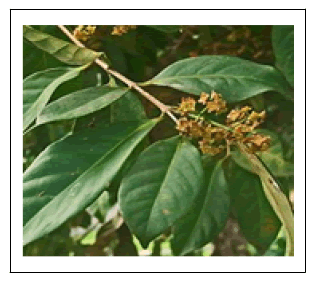
Bay leaves are generally cultivated in European, sub-tropical, tropical and Asian countries. Bay leaves have a variety of phytoconstituents which can decrease the blood cholesterol level and uric acid level, are anti-inflammatory in nature, improve functions of liver, have anticonvulsant and anti-oxidant properties, produce sedative effects, treat diabetes and migraines, have also been used in traditional medicines to treat rheumatism, sprains, indigestion, used to treat blood dysentery and congestion of kidney, relieve indigestion, constipation and sore throat and have wound-healing properties. Following are the chemical structures of the phytoconstituents responsible for the therapeutic potential of bay leaves.
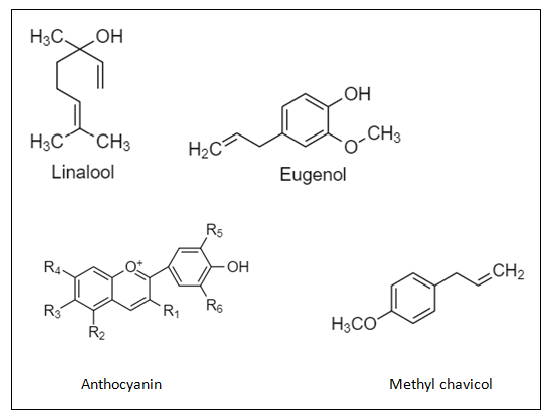
In a study conducted by Nayak et al. in 2006, the wound healing activities of Allamanda cathartica and Laurus nobilis extracts were compared in Sprague Dawley rats. Many excision and incision wound healing models were used for the same. Four groups were formed, wherein groups 1 and 2 were used as reference and groups 3 and 4 as control. Group 3 animals were administered with of 150 mg/kg/day of Allamanda, and group 4 animals were treated with 200 mg/kg b.w/day of Laurus nobilis for 14 days respectively. For studying incision wound healing, the group 3 and 4 animals were administered with doses of Allamanda and Laurus nobilis respectively for 10 days. In the animals treated with bay leaves extract, the rate of wound closure was found to be higher along with more weight of granulation tissue and more content of hydroxyproline content of granulation tissue as compared to animals treated with Allamanda extracts. The animals treated with bay leaf extract were found to have higher number of inflammatory cells and lesser collagen production as compared to those treated with Allamanda extract. Thus, the aqueous extract of bay leaves was found to have better wound healing activity than that of Allamanda
Samejima K et al. in 1998 conducted a study to investigate the antimutagenic activity of 3-kaempferyl p-coumarate against Trp- P-2. IC50 value of Trp-P-2 was found to be 1.9 μgrams. This value was found to be close enough to those of existing antimutagens like flavones and flavonols. After its experimental identification, it was separated through the process of chromatography. The desmutagenic action converts the metabolically activated form of Trp-P-2 into its carcinogenic from and this this is responsible for the antimutagenic action. Also, this compound was found to have weak bioantimutagenicity and could also suppress the mutagenic action of direct mutagens [191-200].
Ferreira et al. in 2006 conducted an in vitro screening to determine the antioxidant and anticholinergic activity of various medicinal plants including bay leaf. The inhibition value of ethanolic extract towards AChE was found to be 1 mg/ml. The free radical scavenging activity was found to be higher in polar extracts of the plants. Maximum plants reported 90% efficacy in polar extracts. Also, the antioxidant activity was measured through β-carotene-linoleic acid assay in which around 65-95% of activity of water extracts was reported [201-210].
Macchioni et al. in 2006 conducted a research to study the composition as well as ascaricidal activity of Laurus nobilis and Laurus novocanariensis essential oils against Psoroptes cuniculi. The oils of plants were analyzed with gas chromatography with FID GC/MS detection. Disks of filter paper soaked up with diluted concentrations of 50 μL essential oils. The mortality rates corresponding to different concentrations of essential oils were recorded after 24 hours of contact with mice and were reported and it was found that essential oil from L. novocanariensis was found to be better than L.nobilis at concentrations of 5% and 10% where it showed mortality rates of 100% at both the concentrations.
Patrakar et al. in 2012 performed a pharmacological review of Laurus nobilis and determined its antifungal effect against seven strains of fungi which are pathogenic to plants. This was in vitro and in concentrations like 50, 125 and 250 micrograms/ml. A very effective antifungal activity was observed against the fungus Botrytis cinerea with the use of 250 micrograms/ml concentration of L.nobilis.
Oregano
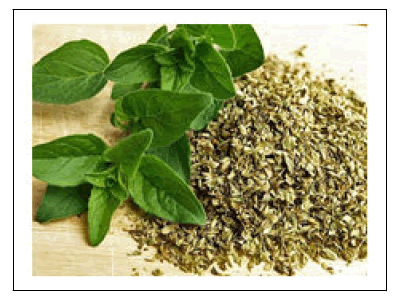
Oregano is a herb native to Mediterranean hills. Many researches have also been conducted to evaluate the antiinflammatory, anti-microbial, antiproliferatvie, cytotoxic, cardiovascular preventive properties and some positive conclusions could be made from the same. Following are the chemical structures of the phytoconstituents responsible for the therapeutic potential of oregano-
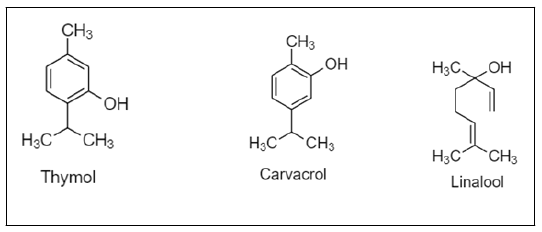
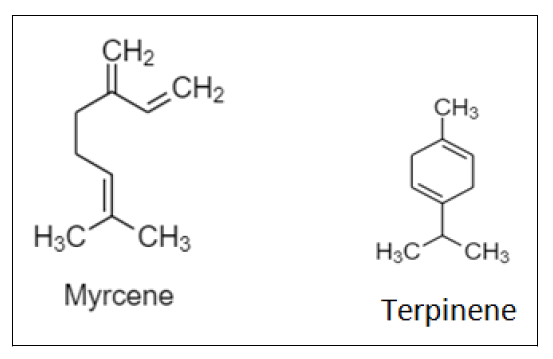
Conducted a study to investigate the effect of chitosan in boosting the antimicrobial activity of oregano essential oil in fresh pork meat packed in a modified atmosphere having 70% O2, 10% N2 and 20% CO2 and then stored at a temperature of 4°C for 15 days. Upon observation, it was noticed that a decrease was recorded in the growth of L. monocytogenes after treatment with chitosan individually or with oregano essential oil. Also, growth inhibition was seen up to 15 days with chitosan and 4% oregano essential oil. The total count of viable cells and spoilage bacteria was also found to be reduced. Chitosan and oregano essential oil applied individually also reduced lipid peroxidation [0.62-0.75 mg malondialdehyde/kg of meat] as compared to control [0.99 mg malondialdehyde/kg of meat]. Conclusively, the treatment with chitosan and oregano essential helped in extending the shelf life of meat as compared with control whose commercial shelf life was 10 days
Conducted a research to study the effect of ethanolic extract from Origanum vulgare in treating Propionibacterium acnes induced ear edema in mice. For this they took ICR mice. In the test group, 2 mg/μl of ethanolic extract from oregano, along with 5% DMSO [dimethyl sulfoxide] was administered. In the control group, a vehicle named DMSO [5%] was administered. 6 × 107 CFU/10 μL PBS of P.acnes was administered in the right ear by intradermal injection and 10 μl of PBS [Phosphatebuffered saline] was injected in right ear. After 24 hours this, the ear swelling in mice was measured and the mice were then euthanized. In the results, it was observed that oregano essential oil reduced ear swelling by 32% and ear weight by 37%.
Evaluated the effects of ethyl acetate extracts of Origanum vulgare in preventing streptozotocin-induced diabetes in C57BL/6 mice. Streptozotocin was administered intraperitoneally in multiple low doses for 5 consecutive days and in a concentration of 40 mg/kg/day. On the other hand, oregano ethyl extract was also administered intraperitoneally at a concentration of 2 mg for 10 consecutive days, with same day administration of both. During the evaluation, it was observed that when taken alone, streptozotocin induced development of 80% of hyperglycemia and ethyl acetate extract of oregano was successful in reducing hyperglycemic development to 15% of mice. After administration of ethyl acetate extract of oregano, the increased/decreased levels of various cytokines and other important substances were recorded as follows in Table 1
| Increased levels |
Decreased levels |
| Concentration of TNF |
Number of F4/80 macrophages |
| Concentration of IL-10 cytokine |
Concentration of IL-1β, IFN-γ, IL-17 and IL-6 cytokines |
| |
Cell counts of Th1 and Th17 |
Table 1: the increased/decreased levels of various cytokines and other important substances.
Conducted a study to evaluate the anti-inflammatory and anti-ulcer properties of carvacrol which is a major monoterpene present in oregano essential oil in male Wistar rats and Swiss mice. The results of dextran and histamine induced paw edema were recorded and it was found that under the influence of carvacrol [50 mg/kg] and cyproheptadine [10 mg/kg], histamine showed highest reduction in edema by 46% and 61% respectively.
The results obtained in substance P induced paw edema were recorded and it was found that carvacrol [100 mg/kg] showed higher percentage reduction in edema of 46% as compared to ruthenium red [3 mg/kg].
The results obtained from TPA induced ear edema were recorded and it was found that indomethacin [0.5 mg/ ear] showed a higher reduction in edema of 55% reduction, as compared to Carvacrol [0.1 mg/ear]. The results obtained from arachidonic acid induced ear edema model were recorded and it was found that indomethacin [2 mg/ ear] showed a higher reduction in edema of 57% as compared to Carvacrol [0.1 mg/ear]. Finally, the results obtained from acetic acid induced gastric lesions test were recorded and it was found that 50 mg/kg of carvacrol showed the highest reduction in area of lesion, the value being 91% reduction
Nutmeg
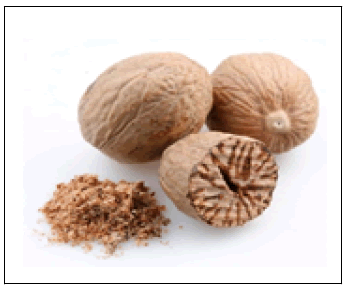
Nutmeg is an age-old spice native to the East Indies and Indonesian provinces. Its therapeutic effects have been of use to treat problems and ailments like gastrointestinal disorders, painful wounds, rheumatic pain and it has been used as a calming agent too.
Various pre-clinical trials have been conducted wherein studies focusing on their anxiolytic, anti-infective, anti-oxidative and anti-inflammatory actions were reported. Following are the chemical structures of the phytoconstituents responsible for the therapeutic potential of nutmeg.
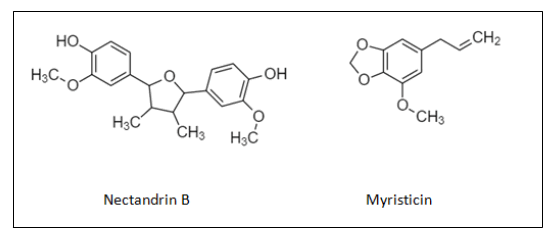
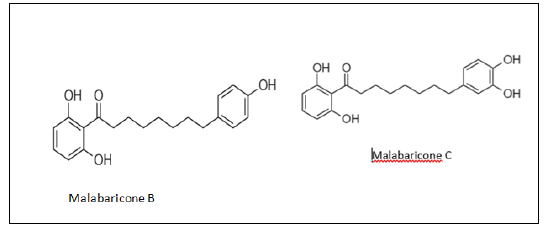
Conducted a study to investigate the hypoglycaemic and hypolipidaemic effects of aqueous nutmeg extract. For this, the rats were given 100 mg/kg dose of nutmeg extract orally, for 30 days after which they were given subcutaneous injections of isoproterenol [85 mg/kg] for 2 consecutive days. In rats administered with isoproterenol, there was an increase in blood glucose level, plasma lipids and lipoprotein lipase activity along with appearance of hyalinization of tissue compared to rats pretreated with nutmeg extract. Also, it was observed that in rats pretreated with aqueous nutmeg extract, the damage to heart tissue was reduced after inducing myocardial infarction by injecting isoproterenol subcutaneously.
conducted a research to study the antifungal effects of lignans obtained from Myristica fragrans on various pathogenic fungi. It was observed that the foliar infection of M.grisea, P.infestans and P.recondita were controlled to some extent by a dose of 500 mg/l of all three lignans extracted from nutmeg. Also, the barley powdery mildew caused by B.graminis could be suppressed to a large extent by 1 day dose of EA6. MDA and NB were found to show significant antifungal effect against plant pathogens causing rice blast and wheat leaf rust and moderate effects against rice sheath blast and tomato late blight. The three lignans of nutmeg could also inhibit and fight these infections in vivo as against crown gall [A.tumefaciens], rice grain rot [B.glumae], bacterial leaf light of konjac plant [A.konjaci] Studied the effect of macelignan, a phytoconstituent obtained from nutmeg, in inhibiting melanosome transfer mediated by protease activated receptor-2 in keratinocytes. A 10 M preparation of macelignan, obtained from nutmeg was suggested to be used as a natural depigmenting agent because of its ability to inhibit melanosome transfer and dendrite formation in B16F10 melanoma cells.
Conducted a study for the detailed analysis of constituents found in nutmeg which can inhibit locomotor activity in mice in a wheel cage.
When administered at doses of 0.5 ml/cage, the inhibition of locomotion was highest and the value of locomotion inhibition recoded was 68.32%.
After administration of 0.1 ml/cage nutmeg essential oil its concentration at different time intervals was recorded and it was found that after 2 hours of time interval, the plasma concentration of Myristicin was found to be the highest, the value being 7.1 mg/ml.
Conclusively, the plasma concentration of these essential oil components could be correlated with the extent to which inhibition of locomotor activity was exhibited by nutmeg essential oil extract.
Saffron
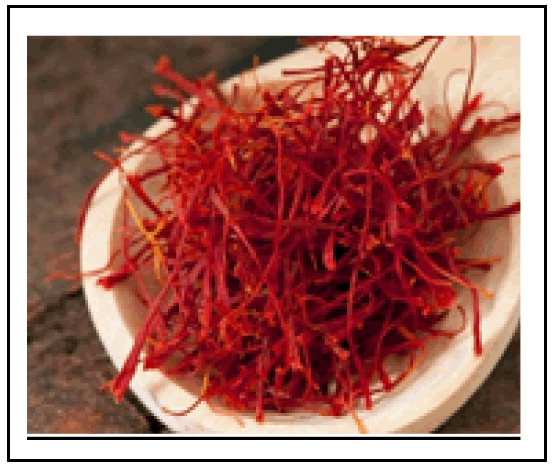
Saffron is a spice cultivated in Afghanistan, Spain, Turkey and Iran. It’s among the world’s most precious and expensive spices. Saffron may be effective in the treatment of a wide spectrum of diseases like coronary heart diseases, stomach diseases, dysmenorrhea, hypertension and even memory and learning impairments.
It can also be used as an antitussive, anticonvulsant, antialzheimer,anti-inflammatory, anti-genotoxic, anti-spasmodic, anti-sclerotic and anti-oxidant agent. Following are the chemical structures of the phytoconstituents responsible for the therapeutic potential of saffron
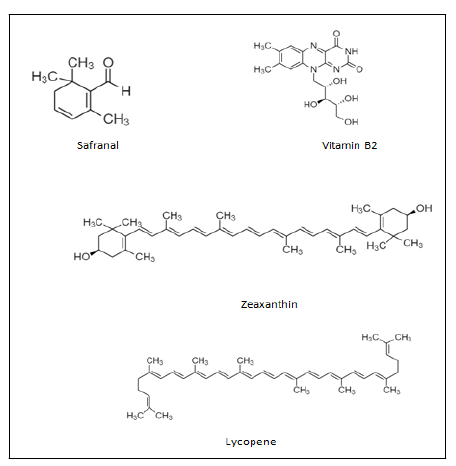
Conducted a study to determine the effects of saffron in chemical induced convulsions in rats. The anti-convulsant activity of saffron was compared to that of sodium valproate in Wistar albino rats. After injecting 700 mg/kg body weight i.v. of Pentylenetetrazol in rats, the test group was administered with 200, 400 and 800 mg/kg body weight of dried powder of saffron and its effects were compared to those of sodium valproate [300 mg/kg body weight] in standard drugs group. It was observed that dried sample of saffron powder delayed the occurrence of convulsions as-well-as delayed the duration of clonic convulsions at concentrations 400 and 800 mg/kg.
conducted a study to determine the antioxidant properties through FRAP analysis and Trolox-equivalent antioxidant capacity and inhibitory properties of saffron on amyloid beta aggregation through thioflavine T-based fluorescent assay and DNA binding shift assay. A water: methanol [50:50, V/V] extract of saffron was prepared and was found to exhibit higher antioxidant properties in comparison with carrots and tomatoes, and also inhibited the amyloid beta fibrillogenesis in a time dependent manner. Thus, the study showed promising results regarding the usage of saffron as a potent anti-oxidant and inhibitor of amyloid beta fibrillogenesis.
conducted a study to conduct the safety evaluation of saffron stigma aqueous extract and Crocin in schizophrenic patients wherein they performed a double-blind placebo-controlled trial on them. Along with the normal treatment, one group of male patients was administered with 2 doses of aqueous saffron extract at a concentration of 15 mg/day daily while the placebo group was administered with 2 doses of Crocin at concentration of 15 mg/day daily. Upon completion of the trial, it was observed that aqueous extract of saffron produced no side effects and increased the WBC cell count which was of no clinical significance as it was under normal range only.
Conducted a study to evaluate the ethanolic and aqueous extracts of saffron, along with its constituents Safranal and Crocin in hyperalgesia and allodynia induced by chronic constriction injury model of neuropathic pain in mice using von Frey filaments, acetone drop and radiant heat tests were performed to evaluate the extent and degree of mechanical allodynia, thermal allodynia and thermal hyperalgesia respectively. The open field test was used to evaluate the ambulatory behavior. For this, a seven day trial was carried out using ethanolic and aqueous extracts using concentrations of 50, 100 and 200 mg/kg i.p. Safranal was administered at concentrations of 0.025, 0.5 and 0.1 mg/kg i.p. It was found that in a dose-dependent manner, these could lessen the behavioral symptoms caused by neuropathic pain.
Rosemary
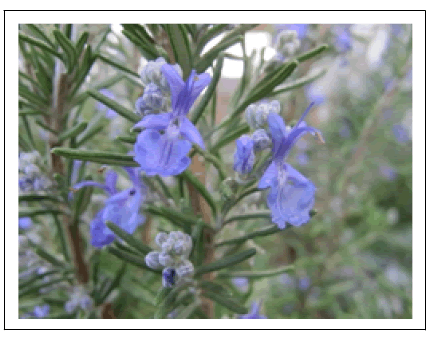
Rosemary is one of the most popular perennial spices cultivated all around the world. The antioxidant property of rosemary extract has also been certified by the European Union. Rosemary has been suggested of exhibiting various pharmacological properties which include antibacterial, anticancer, anti-nociceptive, anti-diabetic, anti-inflammatory, antiulcerogenic, anti-thrombotic, antidiuretic, anti-carcinogenic, and hepatoprotective properties. Following are the chemical structures of the phytoconstituents responsible for the therapeutic potential of rosemary.
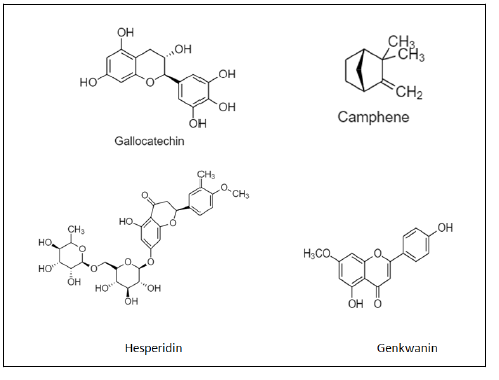
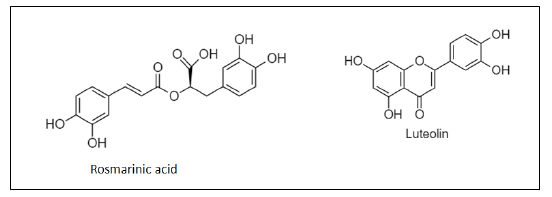
Conducted a study to investigate the fluoxetine-like antidepressive behavior of hydroalcoholic extract of rosemary without altering the learning deficit in Ofactory Bulbectomized [OB] mice. Hydroalcoholic extract and fluoxetine were administered at doses of 10-300 mg/kg and 10 mg/kg p.o., respectively and daily for 14 days in the first set of experiments. In the second set of experiments, serum glucose, hippocampal and cerebrocortical AChE was determined by administering hydroalcoholic extract and fluoxetine at concentrations of 10 mg/kg each. Upon observation, it was found that hydroalcoholic extract at a concentration of 10-300 mg/kg could reduce the OB induced hyperactivity and increased anhedonic and exploratory behavior just like fluoxetine
Conducted a study to investigate the effects of Butylated Hydroxytoluene [BHT] and Butylated Hydroxyanisole [BHA] on growth and production of aflatoxin in Aspergillus. For the experiment, BHT and BHA were administered in toxigenic and non-toxigenic groups of Aspergillus flavus. BHT was administered at concentration of 0.005-0.020 grams/plate and showed no significant inhibitory effects, while BHA administered in the same concentration showed significant inhibitory effect on the growth and toxigenesis of the sample under investigation.
Conducted a study to determine the effects of Chrysamine G [CG] and its derivatives in reducing amyloid beta induced neurotoxicity in mice. First, a new compound, HCG, having low affinity for amyloid beta was synthesized from the monovalent structure of CG. At a concentration of 0.1-1 μM, it was found that both CG and HCG were equally successful in reducing the deaths caused due to amyloid beta induced neurotoxicity. This action of CG was attributed to its antioxidant activity.
Determined the enhanced anti-oxidant effect of α-tocopherol with rosemary extract, in inhibiting the oxidation caused due to Fe2+ and hemoprotein. A mixture of α-tocopherol and rosemary extract was prepared by mixing 0.035% of each constituent and was then administered in sardine oil model. During observations, it was noticed that this mixture produced a quite strong antioxidant effect which was better than that of either extracts. The mixture also prolonged the induction period for 10-16 days when compared to the individual effects of α-tocopherol and rosemary extract. Also, as compared to the effects showed by rosemary extract and α-tocopherol alone, the mixture could reduce the rate of decomposition of highly unsaturated fatty acids, myoglobin, triglycerides and hemoglobin.
Cayenne
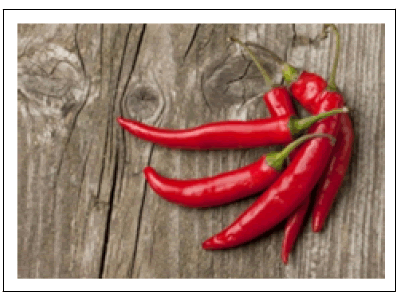
Cayenne is a type of red pepper which originated in South America. It had been used as a part of traditional medicine for treating ailments like sore throat, cough, toothache, rheumatism, eczema, anorexia, bladder hyperactivity, parasitic infections etc. It may also be used as an antiseptic, antioxidant, antitussive, immunostimulant, counterirritant, appetite booster, flatulence, atonic dyspepsia, pepsin as-well-as bile acid secretions. Following are the chemical structures of the phytoconstituents responsible for the therapeutic potential of cayenne

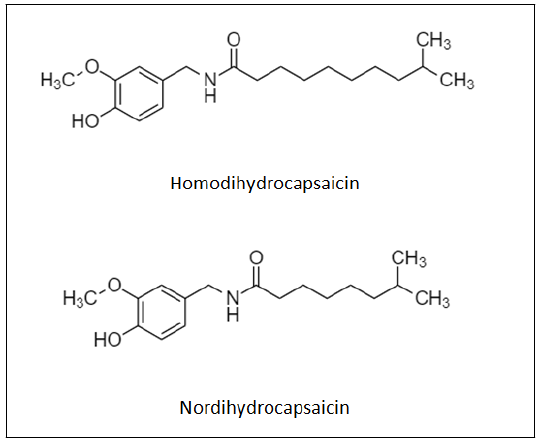
Conducted a study to determine whether plant extracts could stimulate the activity of PPARα receptor activity which is responsible for improving the lipid profile through various mechanisms. It was found that along with the extracts of 3 other plants, cayenne was successful in stimulating the transactivational activities of PPARα receptor. Its phytoconstituent exhibited an EC50 value of 49 μM. Thus, the study was concluded with promising results regarding its effects shown on lipid profile, especially for diseases like dyslipidemia which is the major cause of cardiovascular diseases.
Conducted a study to determine the effect of Aspergillusoryzae fermented kochujang on serum cholesterol in patients of hyperlipidemia. In this, subjects were divided into kochujang and placebo group.
The subjects were administered with either 34.5 grams/day of kochujang or placebo, each thrice a day for 12 days. Upon observation, it was noticed that after administration of kochujang, there was a decrease in total cholesterol and LDL cholesterol levels, while no such effect was seen on the levels of HDL and triglyceride levels.
Conducted a random, double blind and placebo-controlled trial to determine the effects of red pepper and turmeric on oxidative stress biomarkers and inflammation in overweight and obese women. Red pepper was administered at a dosage of 1 gram/day while turmeric at 2.8 grams/day.
Upon observation and analysis, it was found that there was no difference between pre to post supplementation measures of oxidative stress biomarkers and inflammation when compared with the placebo. Also, the scores recorded through PLS-DA analysis were quite insignificant.
Thyme
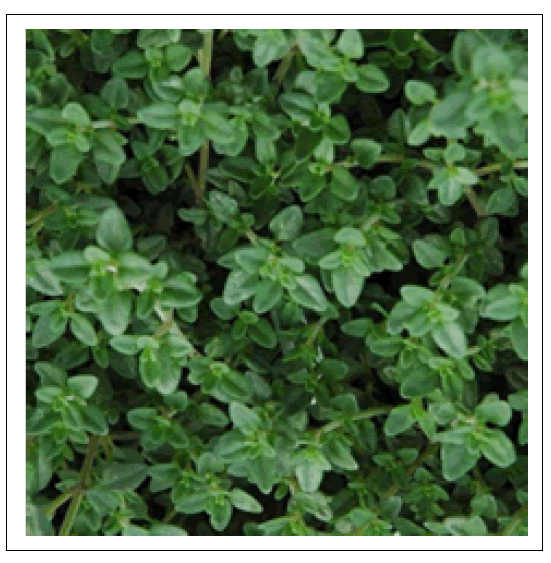
Thyme is a plant native to the Mediterranean region. The ancient Egyptians used it in the process of embalming, Thyme has been found to possess various pharmacological properties and can be used as an antimicrobial, antitussive, expectorant, antibroncholitic, carminative, diuretic, carminative, antispasmodic, anthelmintic, antioxidant agent, etc. Following are the chemical structures of the phytoconstituents responsible for the therapeutic potential of thyme
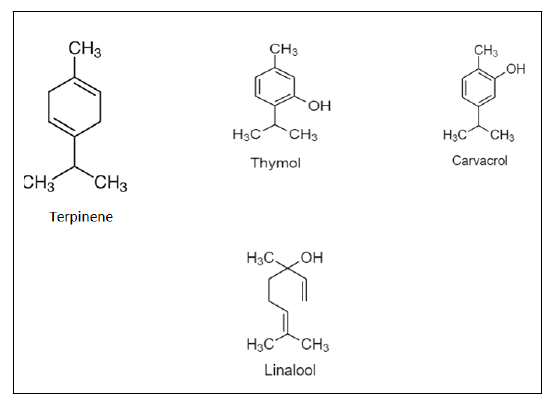
Conducted a study to determine the chemical composition and antimicrobial activity of thyme essential oil. Chemotypes of thymol, carvacrol and linalool were identified using GC-MS analysis. Using the filter paper disc agar diffusion technique, the antimicrobial studies were performed. In the results it was observed that strong, moderate and no inhibition zones were recorded which were evident of the antimicrobial properties possessed by its constituent’s thymol, carvacrol and linalool. Thus, thyme was found to exhibit strong antimicrobial activity.
Conducted a study to analyze and compare the antioxidant, antiradical and antimicrobial effects of 11 different essential oils with that of thyme. After the extraction of essential oils through GC and GC-MS analysis, the DPPH, β-carotene and PCL tests were performed to determine the antioxidant capacities of the essential oils compared to those of thyme. In all the three tests, C.odorata, C.longa and R.officinalis gave the best results regarding inhibition of oxidation. In antimicrobial tests, C.citratus and T. x citriodorus exhibited the best antimicrobial properties against the bacterial strains used.
Conducted a study to determine the chemical composition and antibacterial activity of Thymus vulgaris. The essential oil was extracted through hydrodistillation and then analyzed through GC/MS and GC/FID. The major components identified from the essential oil were camphor, camphene, Borneol, β- pinene, α-pinene and 1, 8-cineole. It was then tested for its antibacterial activity against six gram positive and gram negative bacteria. Thyme essential oil exhibited significant antibacterial activity with and MIC range of 0.33-2.67 mg/ml. Also, the essential oil showed greater antibacterial effects on gram negative bacteria but showed poor effects on gram-positive bacteria.
Performed a research to examine the anti-radical, antiinflammatory and anti-fungal effects of essential oils extracted from Apium graveolens (0.14%) and Thymus vulgaris (0.32%). It was observed that at SC50 values of 0.41 and 0.06 grams/l, Apium graveolens and Thymus vulgaris showed antiradical activity respectively, while at IC50 value of 0.19 grams/l, antiinflammatory effect was shown. Also, out of the fungi tested, Cryptococcus neoformans was found to be the most sensutuve to anti-fungal of Apium graveolens and Thymus vulgaris.
Examined the effects of thyme on broiler diet and efficiency of cytokines in terms of their gene expression profile. It was observed that at a concentration of 5 g/kg, thyme led to an improvement of body weight, feed intake, increased white blood cell, lymphocyte count, nitric oxide and IgG levels, while also enhancing the performance of broilers and their immunity.
Parsley
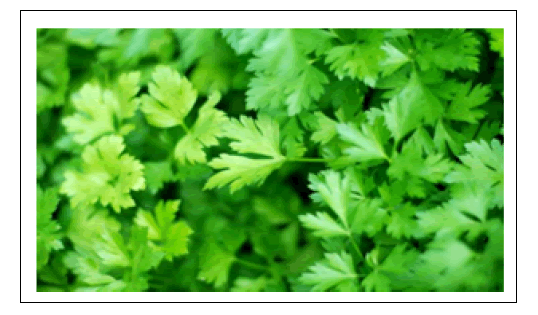
Parsley, a culinary herb, is native to the Mediterranean region. A lot of extensive research has revealed that it can be used as a menorrhagic, antimicrobial, antianemic, anticoagulant, Antihyperlipidemic, Hypoglycaemic, Hypouricemic, Antihepatotoxic, Antioxidant, Antihypertensive, diuretic effects etc. Following are the chemical structures of the phytoconstituents responsible for the therapeutic potential of parsley.
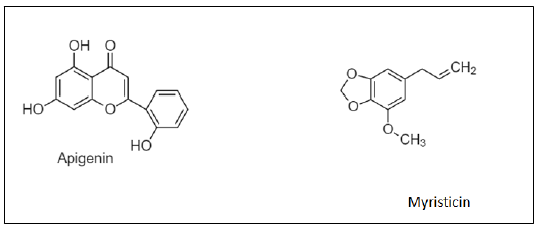
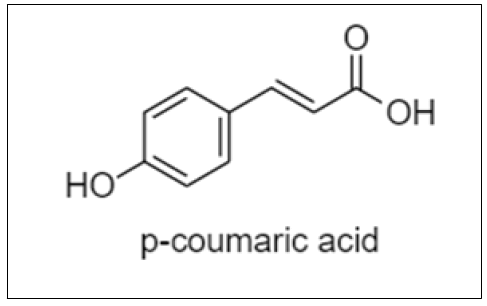
Examined the in-vivo anti-diabetic and hepato-protective effects of leaves obtained from parsley. For this, their aqueous was prepared and administered in STZ-induced diabetic rats at a dose of 5 g/kg for 28 days. The study showed promising results wherein no change in body weight was recorded, while the levels of blood glucose and serum ALT and ALP had decreased significantly, as compared to the control group. Further, the hepatocytes were improved and the degenerative changes were also reduced.
Examined the in-vitro antibacterial effect of hot water and cold water extract of leaves obtained from parsley. For this, 100, 150, 200 and 250 mg/ml of parsley extracts were administered in Staph pyogenes, Staph aureus and Pseudomonas aeruginosa, which were taken from a patient suffering from burn infection. The study showed promising results, wherein both extracts showed anti-bacterial activity. Also, the inhibition zone of hot water extract was found to be better and larger than that of cold water extract.
Performed a study to investigate the in-vitro antimicrobial activity of methanolic extract of leaves obtained from parsley. The effect of 37 μg/ml of this extract was tested on Candida albicans, Aspergillus niger, Saccharomyces cerevisiae, Bacillus subtilis, Escherichia coli, Micrococcus luteus, Pseudomonas aeruginosa, Staphylococcus epidermidis and S.aureus using the agar disk diffusion method..
It was observed that the methanolic extract of parsley leaves showed effective inhibitory activity on P.aeruginosa, B.subtilis, S.aureus, S.cerevisae and S.epidermidis.
Sage
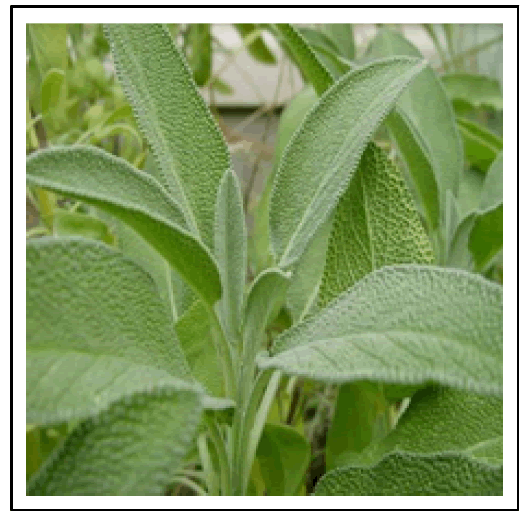
Sage is a plant native to the Mediterranean regions and middle-east. It has been found to exhibit an array of pharmacological effects and thus can be used to treat seizures, gout, rheumatism, ulcers, hyperglycemia, inflammation, tremor, dizziness, diarrhea, paralysis etc. It can also be used an anticancer, anti-nociceptive, anti-inflammatory, antioxidant, antimutagenic, antimicrobial agent etc. Following are the chemical structures of the phytoconstituents responsible for the therapeutic potential of sage.
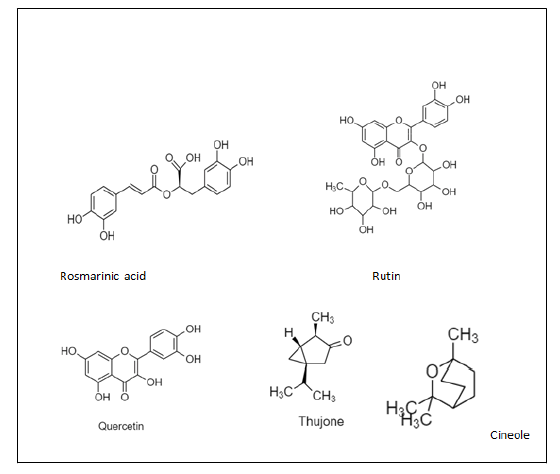
Performed a research to investigate the effects of alcoholic extract of sage on memory and cognitive functions in patients suffering from mild to moderate Alzheimer’s disease. For this, randomised and placebo-controlled trials were carried out wherein the patients were administered with 60 drops of the alcoholic extract every day for 16 weeks. After the specified period, it was observed that there was a significant improvement in the memory and cognitive functions in patients administered with the extract while more frequent agitation was observed in patients of placebo.
Examined the nephroprotective effect of rutin (a phytoconstituent of sage) on Hexachlorobutadiene (HCBD) induced nephrotoxicity in female rats. 24 hours after administration of 100, 500 and 100 mg/kg i.p. of rutin followed by 100 mg/kg i.p. injection of HCBD after 1 hour, it was noticed that there was a decrease in protein, serum creatinine and urea. Further, no such effect was seen on the levels of urine glucose. Pretreatment with rutin was also successful in reversing the depletion in thiol content and elevation in lipid peroxidation due to injection of HCBD.
Investigated the effect of sage Hydroalcoholic (HA) extract on vincristine-induced neuropathy in NMRI male mice. Formalin induced pain response in first and second phase, while administration of HA extract before it was effective in decreasing its pain response in second phase. Vincristine increased pain responses in the second phase and HA extract was effective in treating that too. When compared with the analgesic effects of morphine, it was observed that morphine showed such effects in first phase while HA extract showed the effects in second phase.
Conducted a randomized placebo-controlled trial to investigate the effects of ethanolic extract of sage in improving memory and attention of healthy old volunteers. 167-1332 mg of this ethanolic extract was administered 1, 2.5, 4 and 6 hours before checking for results which revealed improved attention and memory in the volunteers.
Curry leaves
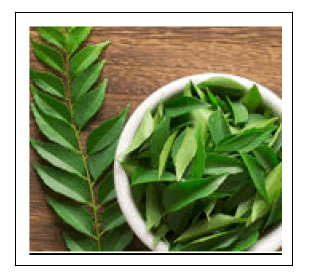
Curry leaves are native to India, Southern and South-east Asia. Curry leaves can be used as anti-inflammatory, anti-tumor, antioxidant, hypoglycemic, anticancer agent, etc. It has also been used in Ayurvedic medicines to provide relief from cough, hypertension, hysteria, rheumatism etc. The phytoconstituents responsible for the therapeutic potential of curry leaves are
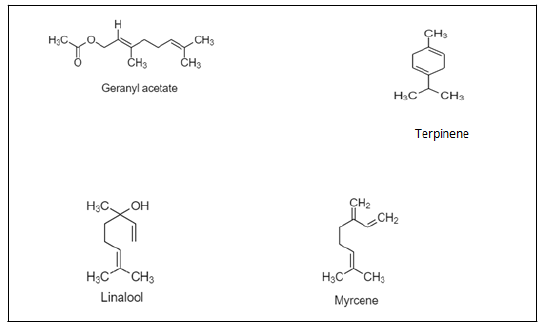
Investigated the antioxidative effects of curry leaves in palm olein using deep-frying and accelerated studies. In tests such as free fatty acid, Oxidative Stability Index, polar and polymer compound content, anisidine value and iodine value, it was observed that 0.2% extract was successful in slowing down the deterioration of oil oxidation and was slightly less efficient than 0.02% butylated hydroxytoluene. In case of fries, it was observed that the extracts were successful in improving the flavour, colour, acceptability and quality of fries.
Conducted a study determine the anti-inflammatory and anticancer effects of curry leaf extracts on male Swiss albino mice. DAL (Dalton’s Ascitic Lymphoma) cells were injected i.p. in mice, 2 days after which 7 mg/kg of SU II was injected while 20 mg/kg of 5-fluorouracil was used as reference. It was found that on 16th day after injection, a reduction in the number of cancer cells and tumour weight was observed which is suggestive of the protective effect in DAL.
Examined the wound healing effects of Murraya koenigii leaves extract. 65 mg/kg of leaf extract was administered in male albino rats. After its administration, it was found that the leaf extract acted against the inflammatory cells and also caused a reduction in the deposition of collagen.
Investigated the anti-amnesic effect of curry leaves extract in aged mice. The aged mice were given a diet containing 2%, 4% and 8% w/w extract for a time period of 30 days. After 30 days it was observed that different concentrations of extracts were successful in reducing the amnesia caused due to diazepam (1 mg/kg i.p.) and scopolamine (0.4 mg/kg i.p.). Also, the extract was successful in reducing the total cholesterol levels along with brain cholinesterase activity.
Allspice
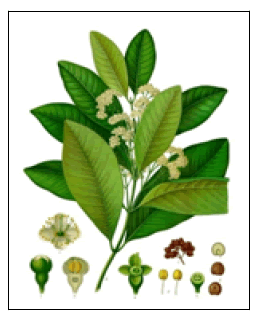
Allspice is a plant native to the tropical forests of South and Central America, West Indies and Southern Mexico. It is known to exhibit anti-bacterial, anti-neuralgic, analgesic, antihypertensive, anti-prostate cancer, anti-breast cancer properties etc. Following are the chemical structures of the phytoconstituents responsible for the therapeutic potential of allspice
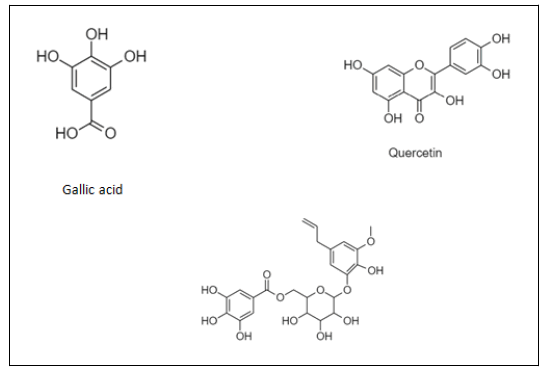
Ericifolin
Investigated the antioxidative effects of polyphenols obtained from berries of allspice. In the DPPH radical scavenging test, it was observed that all the isolated compounds except for kaempferol and its glycosides, showed high radical scavenging activity in the concentration range of 3.125-50 μM.
Conducted a research to determine the anti-plasmodial effects of eugenol, a phytoconstituent found in allspice. It was found that, when tested against Plasmodium falciparum (FCR-3) which is a chloroquine-resistant strain, eugenol showed an IC50 value of 753 μM. This value was far less than those recorded for other phytoconstituents.
Investigated the antiviral activity of eugenol against HSV-1 and HSV-2 viruses. It was found that eugenol inhibited the growth of HSV-1 and HSV-2 with IC50 Values of 25.6 μg/mL and 16.2 μg/mL respectively. The study also revealed the presence of some interactions between eugenol and acyclovir, an antiviral drug. Further, eugenol was also successful in delaying the development of keratitis induced in mouse model due to herpesvirus.
Conducted a study to determine the analgesic activity of eugenol on ICR mice. It was observed that when administered orally in a concentration of 1-10 mg/kg, it exhibited antinociceptive activity in a dose-dependent manner as evident from the contractions produced in the body. The effect could be maintained for a minimum of 30 minutes.
Investigated the effect of Gallic acid in animal model of Parkinson’s Disease (PD). Animals of the test group received 8 μg/2μL 6-hydroxydopamine dissolved in normal saline containing 0.01% ascorbate or vehicle in right Medial forebrain Bundle (MFB), which led to an impairment in motor functions and pallidal electrical power. After administration of 200 mg/kg of Gallic acid, it was observed that it could improve motor dysfunctions and gamma wave power in rats having PD.
Wild mint
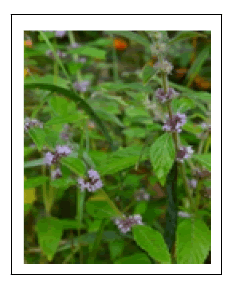
Wild mint is a plant native to the Mediterranean regions, Australia, North Africa, and Europe. Some extensive researches have revealed that it can exhibit a myriad of pharmacological properties which means it can be used as an anti-microbial, antihemolytic, anti-bacterial, anthelmintic, antioxidant agent etc. Following are the chemical structures of the phytoconstituents responsible for the therapeutic potential of wild mint
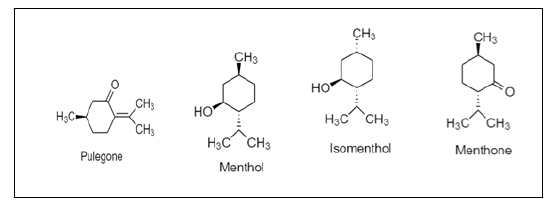
Conducted a study to determine the medicinal use of M.longifolia in diarrhoea and gut spasm through its Calcium channel blocking activity. It was observed that at a concentration range of 100-1000 mg/kg, M.longifolia crude extract provided a protection of 31-80% from diarrhoea in castor oil induced diarrhoea model. The effects produced by it were similar to those of loperamide. Further, in isolated preparation of rabbit jejunum, M.longifolia crude extract inhibited spontaneous as-well-as high K+ induced contractions, with respective EC50 values being 1.80 and 0.60 mg/ml.
Conducted a study to determine the antipyretic and antinociceptive activity of aqueous leaf extract of Mentha longifolia in rats and mice.
The investigations were done using lipopolysaccharide (LPS)- induced pyrexia in rats, and acetic acid and hot plate analgesia tests in mice. It was observed that at a concentration of 37.5-150 mg/kg i.p. the leaf aqueous extract reduced LPS quite significantly. At a concentration of 6.25-100 mg/kg i.p. it reduced the writhes induced by 3% acetic acid. Further, at a concentration of 25-400 mg/kg i.p. the leaf aqueous extract delayed the reaction time of mice in hot plate test in mice.
Examined the ileal relaxation induced by leaf extract of wild mint in rats. The; last portion of ileum of a rat was first mounted on an organ bath and was then contracted by carbachol (CCh, 10 microM), KCl (60 mM) and BaC12 (4 mM).
After this, it was treated with 0.0625-1 mg/ml of hydroalcoholic extract of leaves obtained from M.longifolia. It was observed that in cumulative concentrations and with the same potency, the extract was successful in inhibiting the contractions induced by carbachol, barium chloride and potassium chloride.
Also, when tested against concentrations induced by calcium chloride, the extract inhibited those too, in a concentrationdependent manner (0.25-1 mg/ml).
Jalapeno
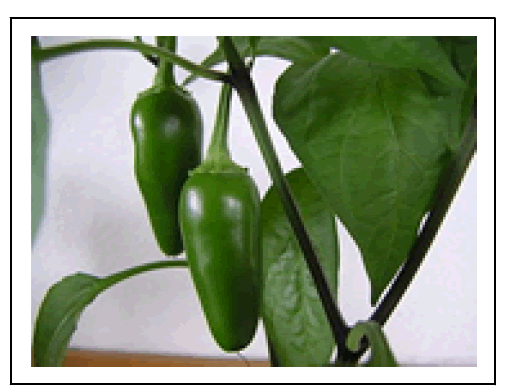
Jalapeno is a type of pepper native to Mexico. Some extensive researches have revealed that various extracts and volatile oils obtained from jalapeno can used as strong and potent antibacterial agents.
Following are the chemical structures of the phytoconstituents responsible for the therapeutic potential of jalapeno
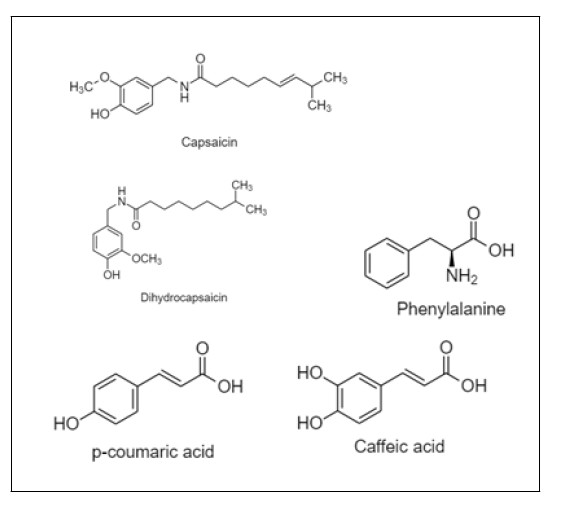
Conducted a study to determine the antimicrobial properties of different extracts of jalapeno prepared in sterilized hot water and varied concentrations of methanol and ethanol (70% and 95% in both). The antibacterial assays were conducted against Listeria monocytogenes, Escherichia coli O157:H7, and Salmonella enterica. The diameter of growth inhibition was then measured. It was observed that Listeria monocytogenes was more susceptible to the extracts than E. coli or Salmonella isolates. Also, the ethanolic and methanolic extracts were found to exhibit better results than sterilized hot water.
Investigated the antimicrobial activities of carvacrol and Cinnamic acid, phytoconstituents of jalapeno, in freshly-cut melon and kiwi fruit at a temperature of 4°C and 8°C. When dipped in a carvacrol solution of 5-15 mM, the total viable counts in kiwi fruit were reduced but some discoloration and bad odour was observed. Further, at 1 mM concentration of carvacrol solution or Cinnamic acid, the total viable count was reduced at both 4°C and 8°C. Further, treatment of hondeydew melon with 1 mM solution of carvacrol and Cinnamic acid also extended the lag phase of microbes. Also, on day-3 of treatment, the viable counts were further reduced.
Conducted a study to determine the inhibitory effects of jalapeno extracts on foodborne pathogenic bacteria. Different Capsaicinoids were separated from jalapeno. Upon observation, it was found that m-coumaric acid and Cinnamic acid were effective in showing inhibitory activity on four of the tested bacteria. It was observed that B.sereus and S.sereus were the most susceptible to these compounds with an inhibition diameter of and 8.2 and 6 mm for cinnamic acid and 10 and 9.8 mm for m-coumaric acid. Listeria was also inhibited by mcoumaric (6.2 mm) acid and Cinnamic acid (5 mm).
Examined the antimicrobial properties of Capsicum species. Two phytoconstituents separated, capsaicin and Dihydrocapsaicin were also tested for their antimicrobial properties. Further, the plain and heated extracts of Capsicum species were tested for their antimicrobial properties using filter disk assay. It was observed that in the presence of extracts, there was a stimulatory effect produced on C.albicans. Also, both cooked and uncooked extracts partially inhibited Bacillus cereus and Bacillius subtilis. Most of the cooked and uncooked extracts partially or completely inhibited C.tetani and Clostridium sporogenes. Similarly, Streptococcus pyogenes was also inhibited due to the effect of both cooked and uncooked extracts of fresh Capsicum leaves [211-219].
Liquorice
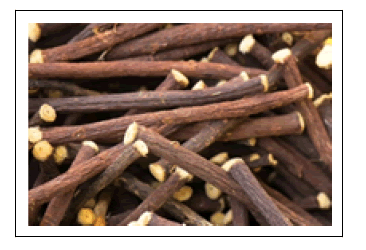
Liquorice is a plant native to the Mediterranean regions, India, China and Russia. It has a lot of therapeutic potential and thus can be used as an anti-bacterial, Antidiabetic, Antiinflammatory, Anti-viral, Anti-oxidant etc. Following are the chemical structures of the phytoconstituents responsible for the therapeutic potential of Liquorice
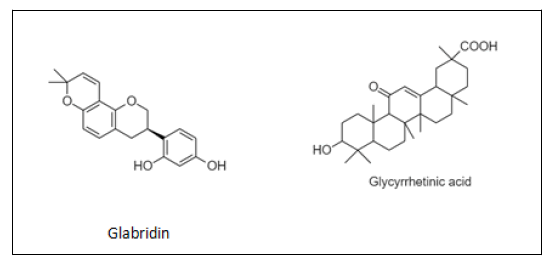
Conducted a study to determine the effects of Glabridin, obtained from liquorice, in reversing learning and memory deficit in diabetic rats. 5, 25 and 50 mg/kg of Glabridin was injected p.o. in streptozotocin-induced diabetic rats and the results were evaluated 30 days later. It was observed that at a dose of 25 and 50 mg/kg, there was an improvement in learning and memory of non-diabetic rats, while the same dose was successful in reversing the learning and memory deficits of diabetic rats. Further, no improvements were recorded at low dose.
In 2012 investigated the efficacy of liquorice root extract in decreasing the transaminase activities in non-alcoholic fatty liver through a randomized controlled trial. After 2 months of administering a capsule of 2 grams aqueous root extract/day, it was observed that the mean alanine aminotransferase (AMT) and mean aspartate aminotransferase (ALT) levels had decreased significantly. No significant difference was recorded in the levels of BMI, before and after the study was conducted.
Examined the hepatoprotective effects of liquorice aqueous extract against CCl4 induced oxidative damage in a rat model. The extract was administered at a concentration of 100-300 mg/kg for a period of 15 days. The extract exhibited promising results wherein it was observed that the aqueous extract of liquorice was successful in arresting inflammatory cytokine production and in stimulation of anti-oxidant enzymes.
Investigated effects of Glabridin, a phytoconstituent of liquorice extract in potentiating the effects of potentiation on GABAA receptor-mediated responses in dorsal raphe neurons. A dose of 10-12-10-8 M of Glabridin was administered in isolated dorsal raphe neurons of rats. The extract showed promising results, wherein it had been successful in producing sedative and hypnotic effects by potentiating GABAergic inhibition in dorsal raphe neurons by GABAA receptor. Examined various topical agents available for the management of hyperpigmentation. In-vivo double blind clinical trials were conducted in human patients wherein 20% of glycyrrhizinic acid, a phytoconstituent of liquorice, was administered at a dose of 20% for 2 weeks. After 2 weeks, it was observed that in patients administered with the dose, there was a reduction of erythema, oedema and itching sores conducted a study to determine the antiviral effects of water extract of Glycyrrhiza in inhibiting enterovirus 71, in the cell line of human fibroblast cell. In the study, 0.1 μg/ml of extract was administered in in-vitro human foreskin cell line. It was observed that the dose was successful in protecting the host cells from enterovirus 71. Further, it was also found that the extract at a concentration of 3000 μg/ml produced only 30% cytotoxicity in the host cells.
Chicory
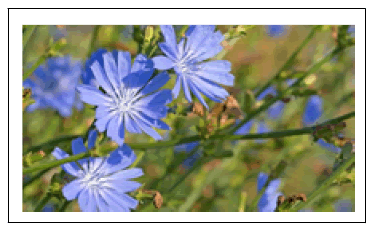
Chicory is a plant grown in many different parts of world. It may exhibit a lot of health-promoting activities and thus can be used as an Anti-bacterial, Anthelmintic, Antiviral, Antimutagenic, Antifungal, Antihepatotoxic, Anticarcinogenic, Anti-oxidative, Immune-stimulant properties etc. Following are the chemical structures of the phytoconstituents responsible for the therapeutic potential of
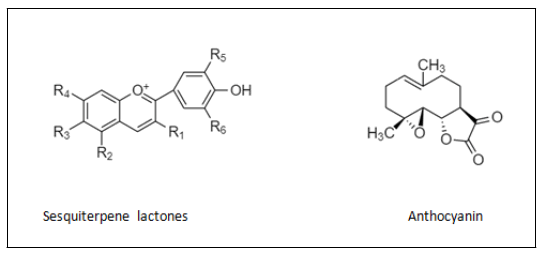
Conducted a study to determine the antibacterial effects of chicory root extracts of both polar and non-polar solvents using the agar well diffusion method. It was observed that at a concentration of 50 μl, the hexane extract showed significant antibacterial activity against all the microorganisms and particularly against B.subtilis, S.aureus and E.coli and ethyl acetate extract against B.subtilis. Further, the petroleum ether extract showed minimum inhibition and water and chloroform extracts showed less inhibition against E.coli. At a dose of 100 μl, the hexane, chloroform and ethyl acetate extracts showed maximum, petroleum ether extract moderate and water extract least inhibition against S.typhi. 100 μl of all extracts was found to be more effective in showing antibacterial properties.
Conducted a randomized, double-blind, placebo-controlled trial to investigate the effects of Cichorium intybus containing Liv-52 tablets on patients having a cirrhotic liver. The test group was administered with Liv-52 tablets and placebo group received placebo tablets. After 6 months, observations were made and it was found that the severity of ascites was reduced, child-pugh score was improved and the serum levels of ALT and AST were significantly reduced in people administered with Liv-52 tablets.
Investigated the immunomodulatory effects of chicory along with four other herbal plants. The activity was examined on human peripheral blood lymphocytes and thymocytes. Upon observation, it was found that at a concentration of 10 μg/ml C.intybus was successful in increasing the cell proliferation when mixed lymphocytes were treated with it
Conducted a study to determine the effects of ethanolic extract of chicory on immunotoxicity by ethanol in mice. 300 mg/kg of extract was administered orally in mice for 28 days, in combination with 20% w/v solution of ethanolic solution. It was observed that, with this combination, the circulation of leukocytes had increased along with the weight of kidney, liver and spleen, secondary IgG antibody response to bovine serum albumin, delayed type hypersensitivity, phagocytic reactions, cell proliferation, natural killer cell activity and interferony secretion.
performed an in-vitro analysis to examine the anthelmintic activity of sesquiterpene lactones obtained from chicory against the egg population of Haemonchus contortus. At the concentration was increased from 0-0.67 mg/ml, the percentage of eggs hatching was reduced to 65%. Further, a concentration of 2.6 mg/ml of sesquiterpene lactones produced 50% lethality as determined by probit dose-effect analysis.
Marjoram
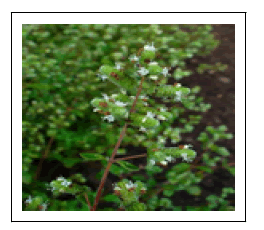
Marjoram is a herb cultivated in the regions of Asia, North Africa, Hungary, Portland, Spain, Egypt, Portugal, Germany and France. It might act a cardioprotective, Antioxidant, Antiplatelet, Antiprotozoal, Antifungal, Antibacterial, Antimetastatic, Antiatherosclerosis, Antitumor, Antiulcer, Anti-cholinesterase activity etc. Following are the chemical structures of the phytoconstituents responsible for the therapeutic potential of marjoram
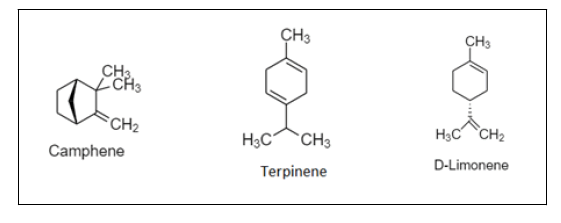
Investigated the anti-platelet activity of methanol extract of leaves obtained from marjoram plant on lamin-coated plates. It was observed that at a concentration of 200 μg/ml, the methanolic extract of leaves obtained from marjoram inhibited the adhesion of platelets to lamin-coated plates by 40%. Further, the treatment with crude methanol extracts also inhibited the self-aggregation and protein secretion from treated platelets.
Conducted a randomized controlled pilot study to examine the effects of marjoram on the hormones of women diagnosed with polycystic ovarian disease (PCOS). After administration of tea twice a day for a month, the results were recorded and it was observed that the marjoram had reduced the levels of DHEA-S and fasting insulin levels in comparison to the placebo group which was given placebo tea for the same time period.
Investigated the potential of marjoram leaves powder and aqueous extract in preventing haematological changes and cardiotoxicity in isoproterenol-treated albino rats. Doses of 50 and 100 mg/kg of body weight were given for 30 continuous days and then tested, it was found that both the powder and extract, in especially in higher dose, were successful in reducing thrombocytosis, erythrocytosis, shortened bleeding time, granulocytosis and the increase in relative heart weight, leakage of heart enzymes and myocardial oxidative stress.
Basil
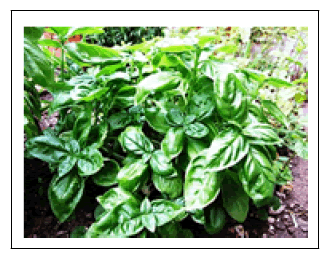
Basil, also known as the ‘Elixir Of Life’ and ‘Queen Of Herbs’ in Ayurveda, is a herb grown mainly in the Indian subcontinent. It is known to keep body free of all ailments and problems. It had been reported to be an agent for curing bronchitis, pyrexia, rheumatism, epilepsy, asthma, hematological diseases, parasitic infections, cardiovascular diseases and neurocognitive disorders. It might also act as an Adaptogenic, Antimicrobial, immunomodulatory and Anti-inflammatory agent. Following are the chemical structures of the phytoconstituents responsible for the therapeutic potential of basil–
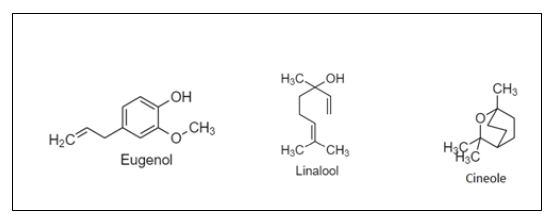
Challenges associated with the usage of culinary spices in healthcare: Even though many spices have been proven of possessing a myriad of health benefits and show a great potential in being used as agents for curing different diseases and ailments, still some more solid evidence is needed which includes conducting regulated and monitored pre-clinical and clinical trials so as to qualify spices as potential agents for curing health problems. Also, every spice has to be used in a certain quantity and to a certain extent only. Even the frequency of consuming the spices has to be taken of. If overused, it can cause more harm than good. To state a few examples, the KADHA recipe, which gained a lot of popularity due to its health benefits in preventing CoVID-19 and normal flu virus, is a mixture of many herbs and spices prepared by boiling the mixture in water. But, some studies have also shown that this kadha, if consumed on a daily basis, might cause problems in the functioning of liver and kidney because of the presence of turmeric in it. Also, if consumed in excess amounts, the same kadha can cause gastrointestinal and stomach related problems like acidity and problems in urinating, as kadha also contains various spices like black pepper, ginger, cloves and black cardamom which produce heat in the body. In a similar way, there are many other spices which have to be consumed only after knowing their right amounts or else the body will have to face the harmful effects. To determine the right concentration and amount of consumption, many more pre-clinical and clinical trials along with extensive studies have to conducted, which would not only establish a firm ground for their usage in healthcare, but would also provide correct information regarding the exact concentration and frequency of using these spices as therapeutic agents. Conclusively, it can be said that without proper research and studies, the right concentration and frequency of consumption of spices cannot be determined and continuous research and studies are required to establish their role as therapeutic agents in the field of healthcare.
The role of indian government in controlling the usage of spices as therapeut c agents in healthcare: In India, the Ministry of Ayush ensures the optimal development and propagation of Ayush systems of healthcare which includes Ayurveda, Unani, Homeopathy, Naturopathy and Siddha systems of medicine and Yoga too. On having a closer look at the India scenario, it is found that unfortunately, no such proper guidelines have been issued by the Ministry of Ayush regarding the optimum concentration and frequency of administration of spices especially in a country like India which is the birth place of such Ayurvedic practices and recipes. Here again, if we consider the example of Kadha, maximum number of people are still not aware of what all spices should be added in what quantity to prepare a kadha. They are also not aware of the contraindications if any, when many different types of spices have to be consumed together in a kadha. As a result of this, when preparing this decoction, people are not able to follow a standardized recipe and procedure as it is not available. In such a scenario, it is the government’s responsibility to release the standard guidelines for preparation and administration of such Ayurvedic recipes which not only include kadha but also different spices consumed on a daily basis, especially in a country like India where spices are an integral component of people’s daily diet. No wonder it has been claimed that plant based drugs and products like spices have been proven of possessing a myriad of therapeutic uses, but it is the sole responsibility of the government to make people aware of the standardized procedure of preparation and frequency of administration of such herbal products.
The global scenario of usage of spices as therapeut c agents: The usage of spices is not just limited to India, but is now prevalent in many other parts of the world too. Different countries around the world have realized the benefits of using spices in healthcare and quite many people prefer using spices as a natural remedy for some sudden ailments. With increasing awareness of the health benefits of spices, the demand for spices is likely to increase in the near future. Presently, many companies sell spices and herbs in different forms for easy administration by the people. Spices like turmeric, cumin seed, black pepper powder, cinnamon, organic ginger, licorice root, cardamom powder and Paprika etc. are being sold in powdered as-well-as capsulated forms. Many of these companies buy spices from most of the south-east Asian countries, after which they mould those spices into a suitable form for easy administration, and then sell it to people around the world. Countries like the USA, the UK, Northern America and Europe have started importing a lot of spices, not just for seasonings, but also for preventing illnesses. The following chart depicts the amount of spices that are likely to be consumed in the near future.
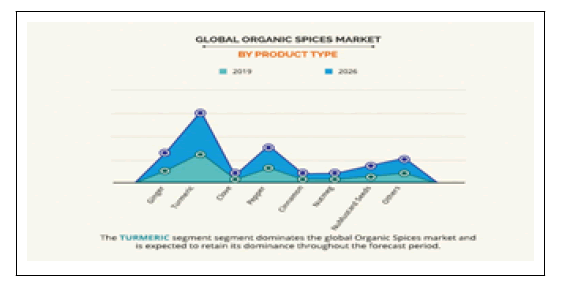
Conclusion
According to the scientific profile of these spices, the
phytoconstituents which they possess are of utmost
importance. Some extensive researches were conducted to
determine the therapeutic potential of these spices and the results have concluded that each of these spices has a myriad of
pharmacological properties which can be beneficial for treating
diseases and problems of gastro intestine, wounds, rheumatic
pain, excessive CNS activity, inflammation, anxiety, oxidation,
infection, etc. They were also found to exhibit Anti-oxidant,
Cardio-protective, Anti-Alzheimer, Anti-convulsant, Antisclerotic,
Anti-proliferative, Anticancer, Anti-nociceptive, Antidiabetic,
Anti-cytotoxic properties. With strong evidence from
some more clinical trials, these spices can be expected to be
used as therapeutic agents around the world.
The researches and studies conducted till now have provided
lot of essential data regarding the therapeutic and
pharmacological properties of the spices mentioned. It is clear
that these spices can provide long term benefits with minimal
side effects as they are completely of plant-origin. Apart from
this, while cultivation of such spices, the raw materials should be
chosen judiciously so as to avoid the interference of foreign
material in the therapeutic phytoconstituents these spices have
been proven of possessing. But, still more extensive research
and exhaustive studies have to be undertaken in-vivo as-well-as
in-vitro environments to establish a more convincing and solid
ground of evidence regarding their therapeutic potential and
adverse effects. In addition to this, it is the responsibility of the
government to standardize, regulate and make people aware of
the usage of spices and herbal ingredients especially those,
which can be prepared in domestic households. Reliable data
and results of clinical studies should be provided to public so as
to promote the usage of spices for therapeutic purposes without
causing any side effects or adverse reactions.
References
- Kolarovic J, Popovic M, Zlinska J, Trivic S, Vojnovic M, et al (2010) Antioxidant activities of celery and parsley juices in rats treated with doxorubicin. Molecules 15:6193–6204
[Crossreff] [Googlescholar] [Pubmed]
- Al Sa’aidi JAA, Alrodhan MNA, Ismael AK (2012) Antioxidant activity of n-butanol extract of celery (Apium graveolens) seed in streptozotocin-induced diabetic male rats. Res Pharm Biotechnol 4:24–29
[Crossreff] [Googlescholar]
- Li P, Jia J, Zhang D, Xie J, Xu X, et al. (2014) In vitro and in vivo antioxidant activities of a flavonoid isolated from celery (Apium graveolens L. var. dulce) Food Funct 5:50–60
[Crossreff] [Googlescholar]
- Nagella P, Ahmad A, Kim SJ, Chung IM (2012) Chemical composition, antioxidant activity and larvicidal effects of essential oil from leaves of Apium graveolens. Immunopharm Immunot 34:205–209
[Crossreff] [Googlescholar] [Pubmed]
- Yildiz L, Başkan KS, Tütem E, Apak R. (2008) Combined HPLC-CUPRAC (cupric ion reducing antioxidant capacity) assay of parsley, celery leaves, and nettle. Talanta 77:304–313
[Crossreff] [Googlescholar] [Pubmed]
- Uddin Z, Shad AA, Bakht J, Ullah I, Jan S, et al. (2015) In vitro antimicrobial, antioxidant activity and phytochemical screening of Apium graveolens. Pak J Pharm Sci 28:1699–1704
[Googlescholar] [Pubmed]
- Naglaa HM, Hassanen A, Eissa MF, Mosa EA (2015) Antioxidant and antimicrobial activity of celery (Apium graveolens) and coriander (Coriandrum sativum) herb and seed essential oils. Int J Curr Microbiol App Sci 4:284–296
[Googlescholar]
- Shanmugapriya R, Ushadevi T (2014) In vitro antibacterial and antioxidant activities of Apium graveolens L. seed extracts. Int J Drug Dev Res. 6:165–170
- Yao Y, Sang W, Zhou M, Ren G (2010) Phenolic composition and antioxidant activities of 11 celery cultivars. J Food Sci 75:C9–C13
[Crossreff] [Googlescholar]
- Akhtar A, Deshmukh AA, Bhonsle AV (2008) In vitro Antibacterial activity of Pimpinella anisum fruit extracts against some pathogenic bacteria. Vet World 1:272–274
[Googlescholar]
- Al-Bayati FA (2008) Synergistic antibacterial activity between Thymus vulgaris and Pimpinella anisum essential oils and methanol extracts. J Ethnopharmacol.116:403–406
[Crossreff] [Googlescholar] [Pubmed]
- Gulcin I, Oktay M, Kirecci E, Kufrevioglu OI (2003) Screening of antioxidant and antimicrobial activities of anise (Pimpinella anisum L.) seed extracts. Food Chem 83:371–382
[Crossreff] [Googlescholar]
- Ates DA, Erdogrul ÖT (2003) Antimicrobial activities of various medicinal and commercial plant extracts. Turk J Biol 27:157–162
[Googlescholar]
- Özcan MM, Chalchat JC (2006) Chemical composition and antifungal effect of anise (Pimpinella anisum L.) fruit oil at ripening stage. Ann Microbiol 56:353–358
[Googlescholar]
- Antioxidant activities of celery and parsley juices in rats treated with doxorubicin
- Janahmadi M, Farajnia S, Vatanparast J, Abbasipour H, Kamalinejad M, et al. (2008) The fruit essential oil of Pimpinella anisum L. (Umblliferae) induces neuronal hyperexcitability in snail partly through attenuation of after-hyperpolarization. J Ethnopharcol 120:360–365
[Crossreff] [Googlescholar] [Pubmed]
- Sahraei H, Ghoshooni H, Hossein Salimi S (2002) The effects of fruit essential oil of the Pimpinella anisum on acquisition and expression of morphine induced conditioned place preference in mice. J Ethnopharcol 80:43–47
[Crossreff] [Googlescholar] [Pubmed]
- Tas A, Özbek H, Atasoy N, Altug ME, Ceylan E (2006) Evaluation of analgesic and antiinflammatory activity of Pimpinella anisum fixed oil extract. Indian Vet J 83:840–843
[Googlescholar]
- Nahidi F, Taherpoor M, Mojab F, Majd H (2008) Effect of Anise extract on hot flush of menopause. Pajoohandeh 13:167–173
- Ciftci M, Goler T, Dalkilic B, Nihat Ertas O (2005) The effect of anise oil (Pimpinella anisum L.) on broiler performance. J Poult Sci 4:851–855
[Googlescholar]
- Shukla HS. (1989) Antiviral properties of essential oils of Foeniculum vulgare and Pimpinella anisum L. Agronomie 9:277–279
[Googlescholar]
- Khoda Karami N, Moattar F, Ghahiri A. (2008) Comparison of effectiveness of an herbal drug(celery, saffron, Anise) and mephnamic acid capsule On primary dismenorrhea. Ofoghe Danesh 14:11–19
- Nickavar B, Abolhasani FAS (2009) Screening of antioxidant properties of seven Umbelliferae fruits from Iran. Pak J Pharm Sci 22:30–35[Crossreff]
[Googlescholar] [Pubmed]
- Carbajal D, Casaco A, Arruzazabala L, Gonzalez R, Tolon Z, et al. (1989) Pharmacological study of Cymbopogon citratus leaves. J. Ethnopharmacol 25:103–107 [Crossreff]
[Googlescholar]
- Lemos TL, Matos FJ, Alencar JW, Craveiro AA, Clark AM, et al. (1990) Antibacterial activity of essential oils of Brazailian plants. Phytother Res 4:82–84
[Crossreff] [Googlescholar]
- Tchoumbougnang F, Zollo PH, Dagne E, Mekonnen Y (2005) In Vivo Antimalarial Activity of Essential Oils from Cymbopogon citratus and Ocimum gratissimum on Mice Infected with Plasmodium berghei. Planta Medica 71:20–23[Crossreff]
[Googlescholar]
- Wannissorn B, Jarikasem S, Soontorntanasart T (1996) Antifungal activity of lemon grass and lemon grass oil cream. Phytother Res 10:551–554
[Crossreff] [Googlescholar]
- Viana GS, Vale TG, Pinho RS, M tos FJ (2000) Antinociceptive effect of the essential oil from Cymbopogon citratus in mice. J Ethnopharmacol 70:323–327
[Crossreff] [Googlescholar] [Pubmed]
- Pedroso RB, Ueda-Nakamura T, Prado B, Filho D, Cortez DA, et al. (2006) Biological Activities of Essential Oil Obtained from Cymbopogon citratus on Crithidia deanei. Acta Protozoologica. 45:231–240
- Chungsamarnvart N, Jiwajinda S. (1992) A caricidal activity of volatile oil from lemon and citronella grasses on tropical cattle ticks. Kasetsart J Nat Sci 26:46–51
[Googlescholar]
- Agbafor KN, Akubugwo EI. (2007) Hypocholesterolaemic effect of ethanolic extract of fresh leaves of Cymbopogon citratus (lemon grass) Afr J Biotechnol 6:596–598
[Crossreff] [Googlescholar]
- Cheel J, Theoduloz C, Rodriäguez J, Hirschmann SG (2005) Free Radical Scavengers and Antioxidants from Lemongrass (Cymbopogon citratus Stapf). J Agric Food Chem 53:2511–2517
[Crossreff] [Googlescholar]
- Adeneye AA, Agbaje EO (2007) Hypoglycemic and hypolipidemic effects of fresh leaf aqueous extract of Cymbopogon citratus Stapf in rats. J Ethnopharmacol 112:440–444
[Crossreff] [Googlescholar]
- Blanco MM, Costa CA, Freire AO, Santos JG, Costa IM, et al. (2007) Neurobehavioral effect of essential oil of Cymbopogon citratus in mice. Phytomedicine 16:265–270
[Crossreff] [Googlescholar]
- Suaeyun R, Kinouchi T, Arimochi H, Vinitketkumnuen U, Ohnishi Y,et al. (1997) Inhibitory effects of lemon grass (Cymbopogon citratus Stapf) on formation of azoxymethane-induced DNA adducts and aberrant crypt foci in the rat colon. Carcinogenesis. 18:949–955
[Googlescholar]
- Nayak S, Nalabothu P, Sandiford S, Bhogadi V, Adogwa A, et al. (2006) Evaluation of wound healing activity of Allamanda cathartica. L. and Laurus nobilis. L. extracts on rats. BMC Complement Altern Med 6:1
[Crossreff] [Googlescholar] [Pubmed]
- Sayyah M, Saroukhani G, Peirovi A, Kamalinejad, M (2003) Analgesic and anti-inflammatory activity of the leaf essential oil of Laurus nobilis Linn. Phytother Res 17:733-736
[Crossreff] [Googlescholar] [Pubmed]
- Elmastaş M, Gülçin I, Işildak Ö, Küfrevioğlu Ö, İbaoğlu K, et al. (2006) Radical scavenging activity and antioxidant capacity of bay leaf extracts. J Iran Chem Soc 3:258–266
[Googlescholar]
- Samejima K, Kanazawa K, Ashida H, Danno G (1998) Bay laurel contains antimutagenic kaempferyl coumarate acting against the dietary carcinogen 3-amino-1-methyl-5 H-pyrido [4, 3-b] indole (Trp-P-2). J Agric Food Chem 46:4864–4868
[Crossreff] [Googlescholar]
- Bilen S., Bulut M (2010) Effects of laurel (Laurus nobilis) on the non-specific immune responses of rainbow trout (Oncorhynchus mykiss, Walbaum). J Anim Vet Adv 9:1275–1279
[Googlescholar]
- Erler F, Ulug I, Yalcinkaya B (2006) Repellent activity of five essential oils against Culex pipiens. Fitoterapia 77:491–494
[Crossreff] [Googlescholar] [Pubmed]
- Macchioni F, Perrucci S, Cioni P, Morelli I, Castilho P, et al.(2006) Composition and acaricidal activity of Laurus novocanariensis and Laurus nobilis essential oils against Psoroptes cuniculi. J Essential Oil Res 18:111–114
[Crossreff] [Googlescholar]
- Ozcan B, Esen M, Sangun M.K, Coleri A, Caliskan M,et al. (2010) Effective Antibacterial and Antioxidant Properties of Methanolic Extract of Laurus Nobilis Seed Oil J Envi Biol 31:637-641
[Googlescholar]
- Derwich E, Benziane Z, Boukir A (2009) Chemical composition and antibacterial activity of leaves essential oil of Laurus nobilis from Morocco. Aust J Basic & Appl Sci 3:3818–3824
[Googlescholar]
- Patrakar R, Mansuriya M, Patil P (2012) Phytochemical and pharmacological review on Laurus nobilis. Int J pharm chem 1:595–602
[Googlescholar]
- Teixeira B, Marques A, Ramos C, Serrano C, Matos O, et al (2013) Chemical composition and bioactivity of different oregano (Origanum vulgare) extracts and essential oil. J Sci Food Agric 93:2707–2714
[Crossreff] [Googlescholar]
- Paparella A, Mazzarrino G, Chaves-Lopez C, Rossi C, Sacchetti G, et al. (2016) Chitosan boosts the antimicrobial activity of Origanum vulgare essential oil in modified atmosphere packaged pork. Food microbiol 59:23–31
[Crossreff] [Googlescholar] [Pubmed]
- Bukovska A, Cikos S, Juhas S, Il’kova G, Rehak P (2007) Effects of a combination of thyme and oregano essential oils on TNBS-induced colitis in mice. Mediators Inflamm 2007:23296
[Crossreff] [Googlescholar] [Pubmed]
- Chuang LT, Tsai TH, Lien TJ, Huang WC, Liu JJ, et al. (2018) Ethanolic Extract of Origanum vulgare Suppresses Propionibacterium acnes-Induced Inflammatory Responses in Human Monocyte and Mouse Ear Edema Models. Molecules (Basel, Switzerland)
[Crossreff] [Googlescholar] [Pubmed]
- Vujicic M, Nikolic I, Kontogianni VG, Saksida T, Charisiadis P, et al. (2016) Ethyl Acetate Extract of Origanum vulgare L. ssp. hirtum Prevents Streptozotocin-Induced Diabetes in C57BL/6 Mice. J Food Sci 81:H1846–1853
[Crossreff] [Googlescholar] [Pubmed]
- Silva F V, Guimarães A G, Silva ERS, Sousa-Neto BP, Machado FDF, et al. (2012) Anti-inflammatory and anti-ulcer activities of carvacrol, a monoterpene present in the essential oil of oregano. J Med Food 15:984–991
[Crossreff] [Googlescholar] [Pubmed]
- Kareem MA, Krushna GS, Hussain SA, Devi KL (2009) Effect of aqueous extract of nutmeg on hyperglycemia, hyperlipidemia and cardiac histology associated with isoproterenol-induced myocardial infarction in rats. Tropical J Pharmaceut Res 8:337–344
[Crossreff] [Googlescholar]
- Cho JY, Choi GJ, Son SW, Jang KS, Lim HK, et al.(2007) Isolation and antifungal activity of lignans from Myristica fragrans against various plant pathogenic fungi. Pest Manag Sci 63:935–940
[Crossreff] [Googlescholar]
- Shafiei Z, Shuhairi NN, Md Fazly Shah Yap N, Harry Sibungkil CA, Latip J,et al. (2012) Antibacterial Activity of Myristica fragrans against Oral Pathogens. Evid Based Complement Alternat Med 2012:825362
[Crossreff] [Googlescholar] [Pubmed]
- Yadav AS, Bhatnagar D (2007) Free radical scavenging activity, metal chelation and antioxidant power of some of the Indian spices. Biofactors 31:219–227
[Crossreff] [Googlescholar] [Pubmed]
- Hayfaa AA, Sahar AM, Awatif MA (2013) Evaluation of analgesic activity and toxicity of alkaloids in Myristica fragrans seeds in mice. J Pain Res 6:611–615
[Crossreff] [Googlescholar] [Pubmed]
- Sonavane GS, Sarveiya VP, Kasture VS, Kasture SB (2002) Anxiogenic activity of Myristica fragrans seeds. Pharmacol Biochem Behav. 71:239–244
[Crossreff] [Googlescholar] [Pubmed]
- Dhingra D, Parle M, Kulkarni SK (2006) Comparative brain cholinesterase-inhibiting activity of Glycyrrhiza glabra, Myristica fragrans, ascorbic acid, and metrifonate in mice. J Med Food 9:281–283
[Crossreff] [Googlescholar] [Pubmed]
- Moinuddin G, Devi K, Kumar Khajuria D (2012) Evaluation of the anti-depressant activity of Myristica fragrans (Nutmeg) in male rats. Avicenna J Phytomed 2:72–78
[Googlescholar] [Pubmed]
- Choi EJ, Kang YG, Kim J, Hwang JK (2011) Macelignan inhibits melanosome transfer mediated by protease-activated receptor-2 in keratinocytes. Biol Pharm Bull. 34:748–754
[Crossreff] [Googlescholar] [Pubmed]
- Muchtaridi, Subarnas A, Apriyantono A, Mustarichie R (2010) Identification of compounds in the essential oil of nutmeg seeds (Myristica fragrans Houtt.) that inhibit locomotor activity in mice. Int J Mol Sci. 11:4771–4781
[Crossreff] [Googlescholar] [Pubmed]
- Sunanda BPV, RammohanB, Amitabh kumar, Kudagi BL (2014) The effective study of aqueous extract of crocus sativus linn In chemical induced convulsants in rats. World J Pharm Pharm Sci 3:1175–1182
[Googlescholar]
- Hosseinzadeh H, Sadeghnia, HR Safranal (2005) a constituent of Crocus sativus (saffron), attenuated cerebral ischemia induced oxidative damage in rat hippocampus. J Pharm Pharm Sci 394–399
[Googlescholar] [Pubmed]
- Akhondzadeh S, Sabet MS, Harirchian M, Togha M, Cheraghmakani H, et al.(2010) Saffron in the treatment of patients with mild to moderate Alzheimer’s disease: a 16‐week, randomized and placebo‐controlled trial. J Clin Pharm Therapeut 35:581–588
[Crossreff] [Googlescholar] [Pubmed]
- Papandreou MA, Polissiou MG, Efthimiopoulos S, Cordopatis P, Margarity M, et al. (2006) Inhibitory activity on amyloid-beta aggregation and antioxidant properties of Crocus sativus stigmas extract and its crocin constituents. J Agric Food Chem 54:8762–8768
[Crossreff] [GooglescholarZ] [Pubmed]
- Noorbala A, Akhondzadeh S, Tahmacebi-Pour N, Jamshidi A (2005) Hydro-alcoholic extract of Crocus sativus L versus fluoxetine in the treatment of mild to moderate depression: a double-blind, randomized pilot trial. J Ethnopharmacol 97:281–284
[Crossreff] [Googlescholar] [Pubmed]
- Purushothuman S, Nandasena C, Peoples CL, Massri ElN, Johnstone DM, et al. (2013) Saffron pre-treatment offers neuroprotection to Nigral and retinal dopaminergic cells of MPTP-Treated mice. J Parkinsons Dis 3:77–83
[Crossreff] [Googlescholar]
- Mousavi BBS, Fadai F, Ashtari Z, Ali beige N, Farhang S, et al.(2015) Safety evaluation of saffron stigma (Crocus sativus L) aqueous extract and crocin in patients with schizophrenia. Avicenna J Phytomed 5:413-419
[Googlescholar] [Pubmed]
- Amin B, Hosseinzadeh H (2012) Evaluation of aqueous and ethanolic extracts of saffron, Crocus sativus L and its constituents,; safranal and crocin in allodynia and hyperalgesia induced by chronic constriction injury model of neuropathic pain in rats. Fitoterapia 83:888–895
[Crossreff] [Googlescholar] [Pubmed]
- Naghibi SM, Mahmoud Hosseini, Fatemeh Khani, Motahare Rahimi, Farzaneh Vafaee, et al.(2012) Effect of Aqueous Extract ofCrocus sativus L on Morphine-Induced Memory Impairment. Adv Pharmacol Sci 2012
[Crossreff] [Googlescholar] [Pubmed]
- Ghoshooni H, Daryaafzoon M, Sadeghi-Gharjehdagi S, Zardooz H, Sahraei H, et al. (2011) Saffron (Crocus sativus) ethanolic extract and its constituent, safranal, inhibits morphine-induced place preference in mice. Pak J Biol Sci 14:939–944
[Crossreff] [Googlescholar] [Pubmed]
- MacHado DG, Cunha MP, Neis VB, Balen GO, Colla AR, et al. (2012) Rosmarinus officinalis L. hydroalcoholic extract, similar to fluoxetine, reverses depressive-like behavior without altering learning deficit in olfactory bulbectomized mice. J Ethnopharmacol 143:158–169
[Crossreff] [Googlescholar]
- Ozarowski M, Mikolajczak PL, Bogacz A, Gryszczynska A, Kujawska M, et al. (2013) Rosmarinus officinalis L. leaf extract improves memory impairment and affects acetylcholinesterase and butyrylcholinesterase activities in rat brain. Fitoterapia. 91:261–271
[Crossreff] [Googlescholar] [Pubmed]
- Probuseenivasan S, Jayakumar M, Ignacimuthu S (2006) In vitro antibacterial activity of some plant essential oils. BMC Complement. Altern Med 6:39
[Crossreff] [Googlescholar] [Pubmed]
- Fung DYC, Taylor S, Kahan J (1977) Effect of butylated hydroxyanisole (BHA) and buthylated hydroxytoluebe (BHT) on growth and aflatoxin production of Aspergillus flavus. J Food Saf 1:39–51
[Crossreff] [Googlescholar]
- Ishii K, Klunk W. E, Arawaka S (2002) Chrysamine G and its derivative reduce amyloid β-induced neurotoxicity in mice. Neurosci Lett 333:5–8
[Crossreff] [Googlescholar]
- Fang X, Wada S (1993) Enhancing the antioxidant effect of α-tocopherol with rosemary in inhibiting catalyzed oxidation caused by Fe2+ and hemoprotein. Food Res Int 26:405–411
[Crossreff] [Googlescholar]
- Hui-Hui Z, Peng-Fei T, Kan Z, Hui W, Bao-Huai W, et al. (2001) Antioxidant properties of phenolic diterpenes from Rosmarinus officinalis. Acta Pharmacol Sin 22:1094–1098
[Googlescholar] [Pubmed]
- Samman S, Sandström B, Toft MB, Bukhave K, Jensen M, et al (2001) Green tea or rosemary extract added to foods reduces nonheme-iron absorption. Am J Clin Nutr 73:607–612
[Crossreff] [Googlescholar] [Pubmed]
- Mueller M, Beck V, Jungbauer A (2011) PPARalpha activation by culinary herbs and spices. Planta Med 77:497–504
[Googlescholar]
- Negulesco J A, Noel S A, Newman HAI (1987) Effect of pure capsaicinoids (capsaicin and dihydrocapsaicin) on plasma lipids and lipoprotein concentrations of turmey poults. Atherosclerosis 64:85–90
[Crossreff] [Googlescholar] [Pubmed]
- Lim JH, Jung ES, Choi EK, Jeong DY, Jo SW, et al. (2015) Supplementation with Aspergillus oryzae-fermented kochujang lowers serum cholesterol in subjects with hyperlipidemia. Clin Nut 34:383–387
[Crossreff] [Googlescholar] [Pubmed]
- Leung FW (2008) Capsaicin-sensitive intestinal mucosal afferent mechanism and body fat distribution. Life Sci 83:1–5
[Crossreff] [Googlescholar] [Pubmed]
- Yoshioka M, St-Pierre S, Drapeau V, Dionne I, Doucet E, et al. (1999) Effects of red pepper on appetite and energy intake. Br J Nutr. 82:115–123
[Googlescholar]
- Lee GR, Shin MK, Yoon DJ, Kim AR, Yu R, et al. (2013) Topical application of capsaicin reduces visceral adipose fat by affecting adipokine levels in high-fat diet-induced obese mice. Obesity 21:115–122
[Crossreff] [Googlescholar] [Pubmed]
- Nieman DC, Cialdella-Kam L, Knab AM, Shanely RA (2012) Influence of red pepper spice and turmeric on inflammation and oxidative stress biomarkers in overweight females:a metabolomics approach. Plant Foods Hum Nutr 67:415–421
[Crossreff] [Googlescholar] [Pubmed]
- Falchi M, Bertelli A, Ferrara F, Galazzo R, Galazzo S, et al. (2008) Intracerebroventricular capsaicin influences the body weight increasing of rats. Brain Res Bull 77:253–256
[Crossreff] [Googlescholar] [Pubmed]
- Zhang H, Matsuda H, Nakamura S, Yoshikawa M (2008) Effects of amide constituents from pepper on adipogenesis in 3T3-L1 cells. Bioorg Med Chem Lett. 18:3272–3277
[Crossreff] [Googlescholar] [Pubmed]
- Kooti W, Daraei N (2017) A Review of the Antioxidant Activity of Celery ( Apium graveolens L). J Evid Based Complementary Altern Med 22:1029-1034
[Crossreff] [Googlescholar] [Pubmed]
- Shojaii A, Abdollahi Fard M (2012) Review of Pharmacological Properties and Chemical Constituents of Pimpinella anisum. ISRN Pharm 2012:510795
[Crossreff] [Googlescholar] [Pubmed]
- Shah G, Shri R, Panchal V, Sharma N, Singh B, et al. (2011) Scientific basis for the therapeutic use of Cymbopogon citratus, stapf (Lemon grass). J Adv Pharm Technol Res 2:3-8
[Crossreff] [Googlescholar] [Pubmed]
- Batool S, Khera RA, Hanif MA, Ayub MA (2020) Bay Leaf. Medicinal Plants of South Asia 63-74
[Crossreff] [Googlescholar]
- Leyva-López N, Gutiérrez-Grijalva EP, Vazquez-Olivo G, Heredia JB (2017) Essential Oils of Oregano: Biological Activity beyond Their Antimicrobial Properties. Molecules 22:989
[Crossreff] [Googlescholar] [Pubmed]
- Abourashed EA, El-Alfy AT (2016) Chemical diversity and pharmacological significance of the secondary metabolites of nutmeg (Myristica fragrans Houtt.). Phytochem Rev 15:1035-1056
[Googlescholar]
- Khazdair MR, Boskabady MH, Hosseini M, Rezaee R, M Tsatsakis A (2015) The effects of Crocus sativus (saffron) and its constituents on nervous system: A review. Avicenna J Phytomed 5:376-391
[Googlescholar] [Pubmed]
- Habtemariam S (2016) The Therapeutic Potential of Rosemary (Rosmarinus officinalis) Diterpenes for Alzheimer's Disease. Evid Based Complement Alternat Med 2016:2680409
[Crossreff] [Googlescholar] [Pubmed]
- Sanati S, Razavi BM, Hosseinzadeh H (2018) A review of the effects of Capsicum annuum L. and its constituent, capsaicin, in metabolic syndrome. Iran J Basic Med Sci 21:439-448
[Crossreff ] [Googlescholar] [Pubmed]
- Borugă O, Jianu C, Mişcă C, Goleţ I, Gruia, et al. (2014) Thymus vulgaris essential oil: chemical composition and antimicrobial activity. J Med Life 3:56-60
[Googlescholar] [Pubmed]
- Mahmood S, Hussain S, Malik F (2014) Critique of medicinal conspicuousness of Parsley(Petroselinum crispum): a culinary herb of Mediterranean region. Pak J Pharm Sci 27:193-202
[Googlescholar]
- Farzaei MH, Abbasabadi Z, Ardekani MR, Rahimi R, Farzaei F (2013) Parsley: a review of ethnopharmacology, phytochemistry and biological activities. J Tradit Chin Med 33:815-26
[Crossreff] [Googlescholar] [Pubmed]
- Ghorbani A, Esmaeilizadeh M (2017) Pharmacological properties of Salvia officinalis and its components. J Tradit Complement Med 7:433-440
[Crossreff] [Googlescholar] [Pubmed]
- Rajendran MP, Pallaiyan BB, Selvaraj N (2014) Chemical composition, antibacterial and antioxidant profile of essential oil from Murraya koenigii (L.) leaves. Avicenna J Phytomed 4:200-214
[Googlescholar] [Pubmed]
- Ghasemzadeh A, Jaafar HZ, Rahmat A, Devarajan T (2014) Evaluation of Bioactive Compounds, Pharmaceutical Quality, and Anticancer Activity of Curry Leaf (Murraya koenigii L.). Evid Based Complement Alternat Med 2014:873803
[Crossreff] [Googlescholar] [Pubmed]
- Zhang L, Lokeshwar BL (2012) Medicinal properties of the Jamaican pepper plant Pimenta dioica and Allspice. Curr Drug Targets 13:1900-1906
[Crossreff] [Googlescholar] [Pubmed]
- Mikaili P, Mojaverrostami S, Moloudizargari M, Aghajanshakeri S (2013) Pharmacological and therapeutic effects of Mentha Longifolia L. and its main constituent, menthol. Anc Sci Life 33:131-138
[Crossreff] [Googlescholar] [Pubmed]
- Bacon K, Boyer R, Denbow C, O'Keefe S, Neilson A, et al. (2017) Antibacterial activity of jalapeño pepper (Capsicum annuum var. annuum) extract fractions against select foodborne pathogens. Food Sci Nutr 5:730-738
[Crossreff] [Googlescholar] [Pubmed]
- Pastorino G, Cornara L, Soares S, Rodrigues F, Oliveira MBPP, et al.(2018) Liquorice (Glycyrrhiza glabra): A phytochemical and pharmacological review Phytother Res 32:2323-2339
[Crossreff] [Googlescholar] [Pubmed]
- Nwafor IC, Shale K, Achilonu MC (2017) Chemical Composition and Nutritive Benefits of Chicory (Cichorium intybus) as an Ideal Complementary and/or Alternative Livestock Feed Supplement. ScientificWorldJournal 2017:7343928
[Crossreff] [Googlescholar]
- G Lal, SS Meena (2018) Medicinal and Therapeutic Potential of Seed Spices. Biomed J Sci&Tech Res 5
[Googlescholar]
- Rota MC, Herrera A, Martínez RM, Sotomayor JA, Jordán MJ, et al.(2008) Antimicrobial activity and chemical composition of Thymus vulgaris, Thymus zygis and Thymus hyemalis essential oils. Food Control 19:681–687
[Crossreff] [Googlescholar]
- Dorman HJD, Deans SG (2000) Antimicrobial agents from plants: antibacterial activity of plant volatile oils. J Appl Microbiol 88:308–316
[Crossreff] [Googlescholar] [Pubmed]
- Sacchetti G, Maietti S, Muzzoli M, Scaglianti M, Manfredini S, et al. (2005) Comparative evaluation of 11 essential oils of different origin as functional antioxidants, antiradicals and antimicrobials in foods. Food Chem 91:621–632
[Crossreff] [Googlescholar]
- Imelouane B, Amhamdi H, Wathelet JP, Ankit M, Khedid K, et al. (2009) chemical Composition and Antimicrobial Activity of Essential Oil of Thyme (Thymus vulgaris) from Eastern Morocco. Int J Agric Biol 11:205–208
[Googlescholar]
- Ballester-Costa C, Sendra E, Fernández-López J, Pérez-Álvarez JA, Viuda-Martos M,et al (2013) Chemical composition and in vitro antibacterial properties of essential oils of four Thymus species from organic growth. Ind Crops Prod 50:304–311
[Crossreff] [Googlescholar]
- Nascimento GGF, Locatelli J, Freitas PC, Silva GL (2000) Antibacterial activity of plant extracts and phytochemicals on antibiotic-resistant bacteria. Braz J Microbiol 31:247–256
[Googlescholar]
- Rizwan B, Zahur M, Azhar N, Khalid S, Sajid N, et al.(2020) Therapeutic potential of Thymus vulgaris: A Review. Annals Res 3:147-161
[Googlescholar]
- Fani M, Kohanteb J (2017) In vitro antimicrobial activity of Thymus vulgaris essential oil against major oral pathogens. J Evid Based 22:660-6
[Crossreff] [Googlescholar] [Pubmed]
- Taleb AM, Qannadi F, Changizi-Ashtiyani S, Zarei A, Rezvanfar MR, et al. (2017) The effect of aqueous extract thymus kotschyanus boiss. Et hohen on glycemic control and dyslipidemia associated with type II diabetes: A randomized controlled trial. Iran J Endocrinol Metab 19:234-43 [Crossreff]
[Googlescholar]
- Kamdem MS, Sameza ML, Dongmo PM, Boyom FF, Bakargna-Via I, et al. (2015) Antiradical, Anti-inflammatory and Antifungal Activities of Essential Oils of Two Aromatic Plants: Apium graveolens (Apiaceae) and Thymus vulgaris (Lamiaceae). J Life Sci 9:51-64
[Googlescholar]
- Hassan FA, Awad A (2017) Impact of thyme powder (Thymus vulgaris L.) supplementation on gene expression profiles of cytokines and economic efficiency of broiler diets. Environ Sci Pollut Res 24:15816-26
[Crossreff] [Googlescholar] [Pubmed]
- Linde GA, Gazim ZC, Cardoso BK, Jorge LF, Tešević V, et al. (2016) Antifungal and antibacterial activities of Petroselinum crispum essential oil. Genet Mol Res 15
[Crossreff] [Googlescholar] [Pubmed]
- Farzaei MH, Abbasabadi Z, Ardekani MR, Rahimi R, Farzaei F, et al. (2013) a review of ethnopharmacology, phytochemistry and biological activities. J Tradit Chin Med 33:815-26
[Crossreff] [Googlescholar] [Pubmed]
- Nielsen SE, Young JF, Daneshvar B (1999) Effect of parsley (Petroselinum crispum) intake on urinary apigenin excretion, blood antioxidant enzymes and biomarkers for oxidative stress in human subjects. Br J Nutr 81:447-455
[Googlescholar]
- Popović M, Kaurinović B, Jakovljević V (2007) Effect of parsley (Petroselinum crispum (Mill.) Nym. ex A.W. Hill, Apiaceae) extracts on some biochemical parameters of oxidative stress in mice treated with CCl(4). Phytother Res 21: 717-723
[Crossreff] [Googlescholar] [Pubmed]
- Bolkent S, Yanardag R, Ozsoy-Sacan O (2004) Effects of parsley (Petroselinum crispum) on the liver of diabetic rats: a morphological and biochemical study. Phytother Res 18: 996-999
[Crossreff] [Googlescholar]
- Aljanaby AAJJ (2013) Antibacterial activity of an aqueous extract of Petroselinum crispum leaves against pathogenic bacteria isolated from patients with burns infections in Al-najaf Governorate, Iraq. Res Chem Intermed 39:3709-3714
[Googlescholar]
- Ojala T, Remes S, Haansuu P, Vuorela H, Hiltunen R, et al. (2000) Antimicrobial activity of some coumarin containing herbal plants growing in Finland. J Ethnopharmacol 73: 299-305
[Crossreff] [Googlescholar] [Pubmed]
- Tang EL, Rajarajeswaran J, Fung S, Kanthimathi MS (2015) Petroselinum crispum has antioxidant properties, protects against DNA damage and inhibits proliferation and migration of cancer cells. J Sci Food Agric 95:2763-2771
[Crossreff] [Googlescholar] [Pubmed]
- Kreydiyyeh SI, Usta J, Kaouk I (2001) The mechanism underlying the laxative properties of Parsley extract. Phytomedicine 8:382-388
[Crossreff] [Googlescholar]
- Akhondzadeh S, Noroozian M, Mohammadi M, Ohadinia S, Jamshidi AH, et al. (2003) Salvia officinalis extract in the treatment of patients with mild to moderate Alzheimer's disease: a double blind, randomized and placebo-controlled trial. J Clin Pharm Ther 8:53-59
[Crossreff] [Googlescholar] [Pubmed]
- Hubbert M, Sievers H, Lehnfeld R, Kehrl W (2006) Efficacy and tolerability of a spray with Salvia officinalis in the treatment of acute pharyngitis – a randomised, double-blind, placebo-controlled study with adaptive design and interim analysis. Eur J Med Res 11:20–26
[Googlescholar] [Pubmed]
- Kianbakht S, Abasi B, Perham M, Hashem Dabaghian F (2011) Antihyperlipidemic effects of Salvia officinalis L. leaf extract in patients with hyperlipidemia: a randomized double-blind placebo-controlled clinical trial. Phytother Res 25:1849–1853
[Crossreff] [Googlescholar] [Pubmed]
- Behradmanesh S, Derees F, Rafieian-kopaei M (2013) Effect of Salvia officinalis on diabetic patients. J Ren Inj Prev 2:51–54
[Crossreff] [Googlescholar] [Pubmed]
- Sadeghnia HR, Yousefsani BS, Rashidfar M, Boroushaki MT, Assadpour E, et al. (2013) Protective effect of rutin on hexachlorobutadiene-induced nephrotoxicity. Ren Fail 35:1151–1155
[Crossreff] [Googlescholar] [Pubmed]
- Abad NAA, Nouri MHK, Tavakkoli F (2011) Effect of Salvia officinalis hydroalcoholic extract on vincristine-induced neuropathy in mice. Chin J Nat Med 9:354–358
[Crossreff] [Googlescholar]
- Badiee P, Nasirzadeh A.R, Motaffaf M (2012) Comparison of Salvia officinalis L. essential oil and antifungal agents against candida species. J Pharm Technol Drug Res 1:7
[Googlescholar]
- Kennedy DO, Pace S, Haskell C, Okello EJ, Milne A, et al. (2006) Effects of cholinesterase inhibiting sage (Salvia officinalis) on mood, anxiety and performance on a psychological stressor battery. Neuropsychopharmacology 31:845–852
[Crossreff] [Googlescholar] [Pubmed]
- Sá C.M, Ramos AA, Azevedo MF, Lima CF, Fernandes-Ferreira M, Pereira-Wilson C (2009) Sage tea drinking improves lipid profile and antioxidant defences in humans. Int J Mol Sci 10:3937–3950
[Crossreff] [Googlescholar] [Pubmed]
- Scholey AB, Tildesley NT, Ballard CG (2008) An extract of Salvia (sage) with anticholinesterase properties improves memory and attention in healthy older volunteers. Psychopharmacol 198:127–139
[Googlescholar]
- Ito C, Itoigawa M, Nakao K (2006) Induction of apoptosis by carbazole alkaloids isolated from Murraya koenigii. Phytomedicine. 13:359–365
[Crossreff] [Googlescholar]
- Mohd Nor F, Suhaila M, Aini IN, Razali I (2009) Antioxidative properties of Murraya koenigii leaf extracts in accelerated oxidation and deep-frying studies. Int J Food Sci 60:1–11
[Crossreff] [Googlescholar] [Pubmed]
- Muthumani P, Venkatraman S, Ramseshu KV (2009) Pharmacological studies of anticancer, anti-inflammatory activities of Murraya koenigii (Linn) Spreng in experimental animals. J Pharm Sci Reh 1:137–141
[Googlescholar]
- Tembhurne SV, Sakarkar DM (2009) Hypoglycemic effects of fruit juice of Murraya koenigii (L) in alloxan induced diabetic mice. Int J Pharmtech Res 1:1589–1593
[Googlescholar]
- Sun F, Zheng XY, Ye J, Wu TT, Wang Jl, et al. (2012) Potential anticancer activity of myricetin in human T24 bladder cancer cells both in vitro and in vivo. Nutr Cancer 64:599–606
[Crossreff] [Googlescholar] [Pubmed]
- Khuntia TK, Panda DS (2011) Evaluation of antibacterial, antifungal and anthelmintic activity of Murraya koenigii Spreng. Int J Pharm Sci Res 2:105-110
- Tembhurne SV, Sakarkar DM (2010) Beneficial Effects of Ethanolic Extract of Murraya Koenigii Linn. Leaves in Cognitive Deficit Aged Mice Involving Possible Anticholinesterase and Cholesterol Lowering Mechanism. Int J Pharmtech Res 21:181-188
- Jain M, Gilhotra R, Singh RP, Mittal J (2017) Curry leaf (Murraya Koenigii): a spice with medicinal property. MOJ Biol Med 2:236–256
[Crossreff] [Googlescholar]
- Prabhu KA, Tamilanban T (2012) Investigation of anti-diabetic activity of stem of Murraya koenigii. Int J Re Pharmacol Pharmacother 1:165–168
[Googlescholar]
- Rageeb MD, Usman MD, Barhate SD (2012) Phytochemical evaluation and effect of antipyretic activity on Murraya koenigii Spreng. Leaves extract. International Int j pharm chem 1:231–236[Crossreff] [Googlescholar] [Pubmed]
- Patidar DK, Yadav N, Nakra V (2010) Wound healing activity of Murraya koenigii leaf extract. Int J Compr Pharm 4:1–2
- Vasudevan M, Parle M (2008) Antiamnesic potential of Murraya koenigii leaves. Phytother Res 23:308–316
[Crossreff] [Googlescholar] [Pubmed]
- Miyajima Y, Kikuzaki H, Hisamoto M, Nikatani N (2004) Antioxidative polyphenols from berries of Pimenta dioica. Biofactors 21:301-303
[Crossreff] [Googlescholar] [Pubmed]
- Suárez A, Ulate G, Ciccio JF (1997) Cardiovascular effects of ethanolic and aqueous extracts of Pimenta dioica in Sprague-Dawley rats. J Ethnopharmacol 5:107-111
[Crossreff] [Googlescholar] [Pubmed]
- Doyle BJ, Frasor J, Bellows LE, Locklear TD, Perez A, et al. (2009) Estrogenic effects of herbal medicines from Costa Rica used for the management of menopausal symptoms. Menopause 16:748-755
[Crossreff] [Googlescholar] [Pubmed]
- Kamatou GP, Vermaak I, Viljoen AM (2012) Eugenol--from the remote Maluku Islands to the international market place: a review of a remarkable and versatile molecule. Molecules 17:6953-6981
[Crossreff] [Googlescholar] [Pubmed]
- Van Zyl RL, Seatlholo ST, van Vuuren SF, Viljoen AM (2006) The biological activities of 20 nature identical essential oil constituents. J Essent Oil Res 18: 129–133
[Crossreff] [Googlescholar]
- Benenciav F, Courrges MC (2000) In vitro and in vivo activity of eugenol on human herpesvirus. Phytother Res 14:495–500
[Crossreff] [Googlescholar] [Pubmed]
- Kurian R, Arulmozhi DK, Veeranjaneyulu A, Bodhankar SL (2006) Effect of eugenol on animal models of nociception. Indian J Pharmacol 38:341–345
[Googlescholar]
- Leem HH, Kim EO, Seo MJ, Choi SW (2011) Anti-oxidant and anti-inflammatory activities of eugenol and its derivatives from clove (Eugenia caryophyllata Thunb.). J Korean Soc Food Sci Nutr 40:1361–1370
[Googlescholar]
- Daniel AN, Sartoretto SM, Schmidt G, Caparroz-Assef SM,Bersani-Amado CA, et al. Anti-inflammatory and antinociceptive activities of eugenol essential oil in experimental animal models. Rev Bras Parmacogn 19:212–217
[Crossreff] [Googlescholar]
- Park, SH, Sim YB, Lee JK, Kim SM, Kang YJ, et al. (2011) The analgesic effects and mechanisms of orally administered eugeno. Arch Pharm Res 34: 501–507
[Crossreff] [Googlescholar] [Pubmed]
- Carson CF, Hammer KA, Riley TV (2006) Melaleuca alternifolia (Tea Tree) oil: a review of antimicrobial and other medicinal properties. Clin Microbiol Rev 19:50-62
[Crossreff] [Googlescholar] [Pubmed]
- Sameri MJ, Sarkaki A, Farbood Y, Mansouri SMT (2011) Motor disorders and impaired electrical power of pallidal EEG improved by Gallic acid in animal model of parkinson’s disease. Pak J Biol Sci 14:1109–1116
[Crossreff] [Googlescholar]
- Mimica-Dukić N, Bozin B, Soković M, Mihajlović B, Matavulj M (2003) Antimicrobial and antioxidant activities of three Mentha species essential oils. Planta Med. 69:413-419
[Crossreff] [Googlescholar] [Pubmed]
- Pérez Raya MD, Utrilla MP, Navarro MC, Jiménez J (2006) CNS activity of Mentha rotundifolia and Mentha longifolia essential oil in mice and rats. Phytother Res 4:232–234
[Crossreff] [Googlescholar]
- Shah AJ, Bhulani NN, Khan SH, Ur Rehman N, Gilani AH, et al. (2010) Calcium channel blocking activity of Mentha longifolia L. explains its medicinal use in diarrhoea and gut spasm. Phytother Res 24:1392-1397
[Crossreff] [Googlescholar] [Pubmed]
- Gulluce M, Sahin F, Sokmen M, Ozer H, Daferera D, et al. (2007) Antimicrobial and antioxidant properties of the essential oils and methanol extract from Mentha longifolia L. ssp. longifolia. Food Chem 103:1449–1456.
[Crossreff] [Googlescholar]
- El-Badry AA, Al-Ali KH, El-Badry YA (2010) Activity of Mentha longifolia and Ocimum basilicum against Entamoeba histolytica and Giardia duodenalis. Sci Parasitol 11:109–117
[Googlescholar]
- Amabeoku GJ, Erasmus SJ, Ojewole JA, Mukinda JT (2009) Antipyretic and antinociceptive properties of Mentha longifolia Huds. (Lamiaceae) leaf aqueous extract in rats and mice. Methods Find Exp Clin Pharmacol 31(10):645-649
- Naseri MK, Naseri ZG, Mohammadian M, Birgani MO (2008) Ileal relaxation induced by Mentha longifolia (L.) leaf extract in rat. Pak J Biol Sci 11:1594-1599
[Googlescholar] [Pubmed]
- Berselli PV, Zava S, Montorfano G, Corsetto PA, Krzyzanowska J (2010) A mint purified extract protects human keratinocytes from short-term, chemically induced oxidative stress. J Agric Food Chem 58:11428-11434
[Crossreff] [Googlescholar]
- Pajohi MR, Tajik H, Farshid AA, Basti AA, Hadian M, et al.(2011) Effects of Mentha longifolia L. essential oil and nisin alone and in combination on Bacillus cereus and Bacillus subtilis in a food model and bacterial ultrastructural changes. Foodborne Pathog Dis 8:283-290
[Crossreff] [Googlescholar] [Pubmed]
- Ahmad N, Fazal H, Ahmad I, Abbasi BH (2012) Free radical scavenging (DPPH) potential in nine Mentha species. Toxicol Ind Health 28:83-89
[Crossreff] [Googlescholar] [Pubmed]
- Baris O, Karadayi M, Yanmis D, Guvenalp Z, Bal T, et al. (2011) Isolation of 3 flavonoids from Mentha longifolia (L.) Hudson subsp. longifolia and determination of their genotoxic potentials by using the E. coli WP2 test system. J Food Sci 76:T212-217
[Crossreff] [Googlescholar] [Pubmed]
- Bacon K, Boyer R, Denbow C, O'Keefe S, Neilson A, et al. (2016) Evaluation of different solvents to extract antibacterial compounds from jalapeño peppers. Food Sci Nutr 5:497-503
[Crossreff] [Googlescholar] [Pubmed]
- Wen A, Delaquis P, Stanich K, Toivonen P (2003) Anti‐listerial activity of selected phenolic acids. Food Microbiology, 20:305–311
[Crossreff]
- Roller S, Seedhar P (2002) Carvacrol and cinnamic acid inhibit microbial growth in fresh-cut melon and kiwifruit at 4 degrees and 8 degrees C. Lett Appl Microbiol 35:390-394
[Crossreff] [Googlescholar] [Pubmed]
- Dorantes L, Colmenero R, Hernandez H, Mota L, Jaramillo ME, et al. (2000) Inhibition of growth of some foodborne pathogenic bacteria by Capsicum annum extracts. Int J Food Microbiol 57:125–128
[Crossreff] [Googlescholar]
- Careaga M, Fernández E, Dorantes L, Mota L, Jaramillo ME, et al.(2003) Antibacterial activity of Capsicum extract against Salmonella typhimurium and Pseudomonas aeruginosa inoculated in raw beef meat. Int J Food Microbiol 83:331-335
[Crossreff] [Googlescholar] [Pubmed]
- De Marino S, Iorizzi M, Zollo F (2008) Antioxidant activity and biological properties of phytochemicals in vegetables and spices (Capsicum, Laurus, Foeniculum). Elec J Env Agricult Food Chem 7:3174–3177
- Cichewicz, RH, Thorpe PA (1996) The antimicrobial properties of chile peppers (Capsicum species) and their uses in Mayan medicine. J Ethnopharmacol 52:61–70
[Crossreff] [Googlescholar] [Pubmed]
- Hasanein P (2011) Glabridin as a major active isoflavan from Glycyrrhiza glabra (licorice) reverses learning and memory deficits in diabetic rats. Acta Physiol Hung 98:221–230
[Crossreff] [Googlescholar] [Pubmed]
- Dhingra D, Sharma A (2006) Antidepressant‐like activity of Glycyrrhiza glabra L. in mouse models of immobility tests. Prog Neuropsychopharmacology Biol Psychiatr 30:449–454
[Crossreff] [Googlescholar] [Pubmed]
- Tamir S, Eizenberg M, Somjen D, Izrael S, Vaya J, et al. (2001) Estrogen-like activity of glabrene and other constituents isolated from licorice root. J. Steroid Biochem. Mol. Biol. J Steroid Biochem, 78:291–298
- Parle M, Dhingra D, Kulkarni SK (2004) Memory-strengthening activity of Glycyrrhiza glabra in exteroceptive and interoceptive behavioral models. J Med Food Winter 7:462-466
- Hajiaghamohammadi AA, Ziaee A, Samimi R (2012) The efficacy of licorice root extract in decreasing transaminase activities in non-alcoholic fatty liver disease: a randomized controlled clinical trial. Phytother Res 26:1381-1384
- Huo HZ, Wang B, Liang YK, Bao YY, Gu Y, et al. (2011) Hepatoprotective and antioxidant effects of licorice extract against CCl₄-induced oxidative damage in rats. Int J Mol Sci 12:6529-6543
- Damle, M (2014) Glycyrrhiza glabra (liquorice)—A potent medicinal herbInt. J Herb Med, 2:132–136
- Sianne S, Fanie RVH (2002) Antimalarial activity of plant metabolites. Nat Prod Rep 19:675-692
- Jin, Z, Kim S, Cho S, Kim IH, Han D, et al. (2013) Potentiating effect of glabridin on GABAA receptor‐mediated responses in dorsal raphe neurons. Planta Medica 79:1408–1412
- Halder RM, Richards GM (2004) Topical agents used in the management of hyperpigmentation. Skin Ther Lett 9:1–3
- Kuo KK, Chang J S, Wang K C, Chiang L C (2009) Water extract of Glycyrrhiza uralensis inhibited enterovirus 71 in a human foreskin fibroblast cell line. Am J Chin Med 37:383–394
- Cinatl J, Morgenstern B, Bauer G, Chandra P, Rabenau H, et al. (2003) Glycyrrhizin, an active component of liquorice roots, and replication of SARS‐associated coronavirus. The Lancet, 361: 2045–2046
- Su Wei Poh, Voon V, Chen Yong P, Viseswaran N, Chia Y Y,et al. (2015) Estrogenicity of glabridin in Ishikawa cell PLoS One 10:e0121382
- Street RA, Sidana J, Prinsloo G (2013) Cichorium intybus: Traditional Uses, Phytochemistry, Pharmacology, and Toxicology. Evid Based Complement. Alternat Med 2013:579319
- Nandagopal S Kumari RBD (2007) Phytochemical and antibacterial studies of chicory (Cichorium intybus L.)—a multipurpose medicinal plant. Adv Biol Res 1:17–21
[Googlescholar]
- Cohen MM (2014) Tulsi-Ocimum sanctum: A herb for all reasons. J Ayurveda Integr Med. 5:251-259
- Jamshidi N, Cohen MM (2017) The Clinical Efficacy and Safety of Tulsi in Humans: A Systematic Review of the Literature. Evid Based Complement Alternat Med 2017:9217567
[Crossreff] [Googlescholar]
- Bischoff TA, Kelley CJ, Karchesy Y, Laurantos M, Nguyen-Dinh P, et al. (2004) Antimalarial activity of Lactucin and Lactucopicrin: sesquiterpene lactones isolated from Cichorium intybus L. J Ethnopharmacol 95:455–457
[Googlescholar] [Pubmed]
- Huseini HF, Alavian SM, Heshmat R, Heydari MR, Abolmaali K (2005) The efficacy of Liv-52 on liver cirrhotic patients: a randomized, double-blind, placebo-controlled first approach. Phytomedicine 12:619-624
[Crossreff] [Googlescholar] [Pubmed]
- Pushparaj PN, Low HK, Manikandan J, Tan BK, Tan CH (2007) Anti-diabetic effects of Cichorium intybus in streptozotocin-induced diabetic rats. J Ethnopharmacol 111:430-434
[Googlescholar]
- Gürbüz I, Ustün O, Yeşilada E, Sezik E, Akyürek N (2002) In vivo gastroprotective effects of five Turkish folk remedies against ethanol-induced lesions. J Ethnopharmacol 83:241-4
[Crossreff] [Googlescholar] [Pubmed]
- Wesołowska A, Nikiforuk A, Michalska K, Kisiel W, Chojnacka-Wójcik E, et al. (2006) Analgesic and sedative activities of lactucin and some lactucin-like guaianolides in mice. J Ethnopharmacol. 7:254-258
[Crossreff] [Googlescholar] [Pubmed]
- Hazra B, Sarkar R, Bhattacharyya S, Roy P (2002) Tumour inhibitory activity of chicory root extract against Ehrlich ascites carcinoma in mice. Fitoterapia 73:730-733
[Crossreff] [Googlescholar] [Pubmed]
- Kim HM, Kim HW, Lyu YS, Won JH, Kim DK, et al. (1999) An NH. Inhibitory effect of mast cell-mediated immediate-type allergic reactions by Cichorium intybus. Pharmacol Res 40:61-65
- Amirghofran Z, Azadbakht M, Karimi MH (2000) Evaluation of the immunomodulatory effects of five herbal plants. J Ethnopharmacol 72:167-172
[Crossreff] [Googlescholar] [Pubmed]
- Kim JH, Mun YJ, Woo WH, Jeon KS, An NH, et al. (2002) Effects of the ethanol extract of Cichorium intybus on the immunotoxicity by ethanol in mice. Int Immunopharmacol 2:733-44
[Crossreff] [Googlescholar] [Pubmed]
- Foster JG, Cassida KA, Turner KE (2011) In vitro analysis of the anthelmintic activity of forage chicory (Cichorium intybus L.) sesquiterpene lactones against a predominantly Haemonchus contortus egg population. Vet Parasitol 180:298-306
[Crossreff] [Googlescholar] [Pubmed]
- Guerra-Boone L, Alvarez-Román R, Alvarez-Román R, Salazar-Aranda R, Torres-Cirio A, Rivas-Galindo VM, et al. (2015) Antimicrobial and antioxidant activities and chemical characterization of essential oils of Thymusvulgaris, Rosmarinus officinalis, and Origanum majorana from northeastern México. Pak J Pharm Sci 28:363-369
- Charai M, Mosaddak M, Faid M (1996) Chemical composition and antimicrobial activities of two aromatic plants: Origanum majorana L. and O. compactum Benth. J Essential Oil Res 8:657–664
[Crossreff] [Googlescholar]
- Yazdanparast R, Shahriyary L (2008) Comparative effects of Artemisia dracunculus, Satureja hortensis and Origanum majorana on inhibition of blood platelet adhesion, aggregation and secretion. Vascul Pharmacol 48:32–37
[Crossreff] [Googlescholar] [Pubmed]
- Rao Sh, Timsina B, Nadumane VK. (2014) Evaluation of the anticancer potentials of Origanum marjorana on fibrosarcoma (HT-1080) cell line. Asian Pac J Trop Dis 4:S389–S394
[Crossreff] [Googlescholar]
- Al-Howiriny T, Alsheikh A, Alqasoumi S, Al-Yahya M, ElTahir K, et al. (2009) Protective Effect of Origanum majorana L. 'Marjoram' on various models of gastric mucosal injury in rats. Am J Chin Med. 37:531-545
[Crossreff] [Googlescholar] [Pubmed]
- Mossa AT, Refaie AA, Ramadan A, Bouajila J (2013) Amelioration of prallethrin-induced oxidative stress and hepatotoxicity in rat by the administration of Origanum majorana essential oil. Biomed Res Int 2013:859085
[Crossreff] [Googlescholar] [Pubmed]
- Kozlowska M, Laudy AE, Starościak BJ, Napiórkowski A, Chomicz L, et al. (2010) Starosciak BJ. Antimicrobial and antiprotozoal effect of sweet marjoram (Origanum majorana L.) Acta Sci Pol Hortorum Cultus 9:133–141
[Googlescholar]
- Mossa AT, Nawwar GA (2011) Free radical scavenging and antiacetylcholinesterase activities of Origanum majorana L. essential oil. Hum Exp Toxicol 30:1501–1513
[Crossreff] [Googlescholar] [Pubmed]
- Haj-Husein I, Tukan S, Alkazaleh F (2016) The effect of marjoram (Origanum majorana) tea on the hormonal profile of women with polycystic ovary syndrome: a randomised controlled pilot study. J Hum Nutr Diet 29:105-111.
[Googlescholar] [Pubmed]
- Ramadan G, El-Beih NM, Arafa NM, Zahra MM (2013) Preventive effects of Egyptian sweet marjoram (Origanum majorana L.) leaves on haematological changes and cardiotoxicity in isoproterenol-treated albino rats. Cardiovasc Toxicol. 13:100-109
[Googlescholar] [Pubmed]
- Hussain AI, Anwar F, Rasheed SH (2011) Composition, antioxidant and chemotherapeutic properties of the essential oils from two Origanum species growing in Pakistan. Rev Bras Farmacogn. 21:943-952
[Googlescholar]
Citation: Walia R, Saxena S, Singh A, Madaan R, Madaan S, et al. (2022) Therapeutic Potential of Culinary Spices. Int J Drug Dev Res Vol:14 No:1


















































